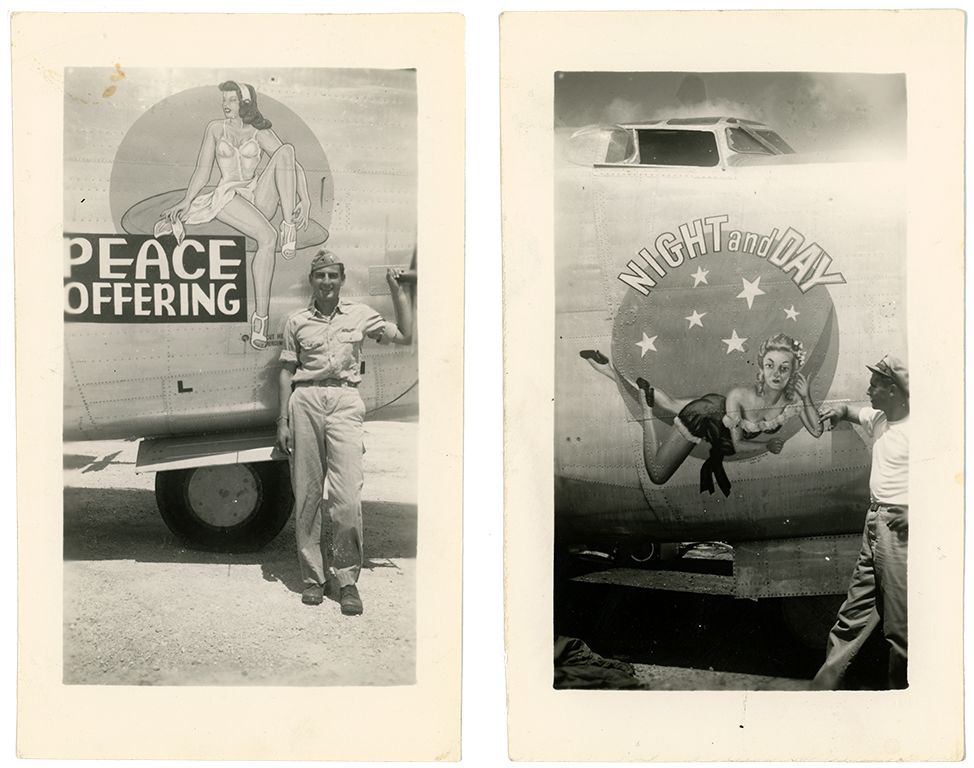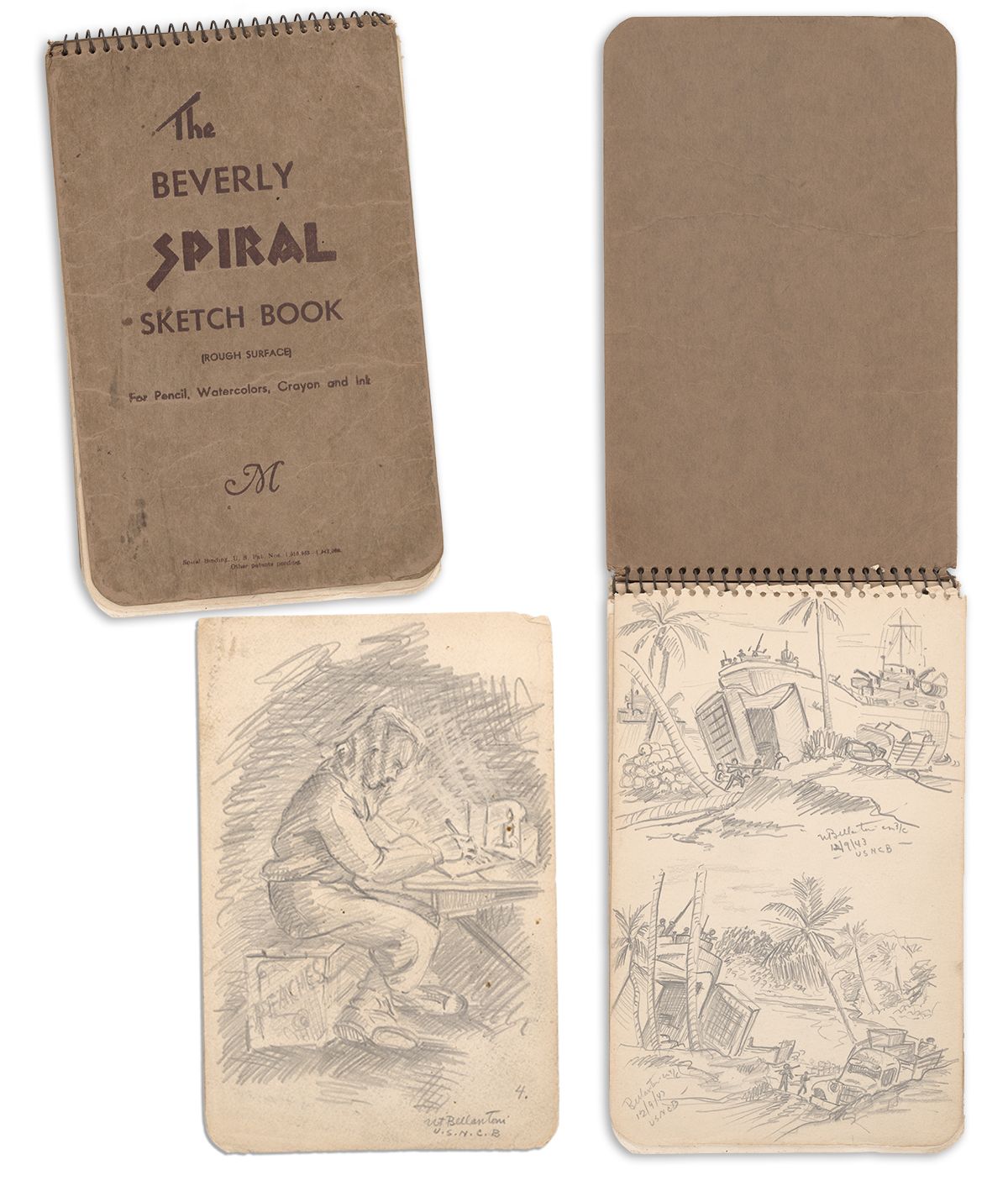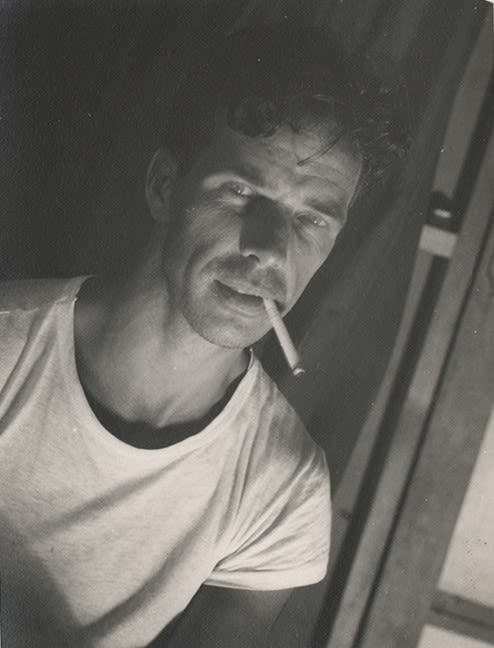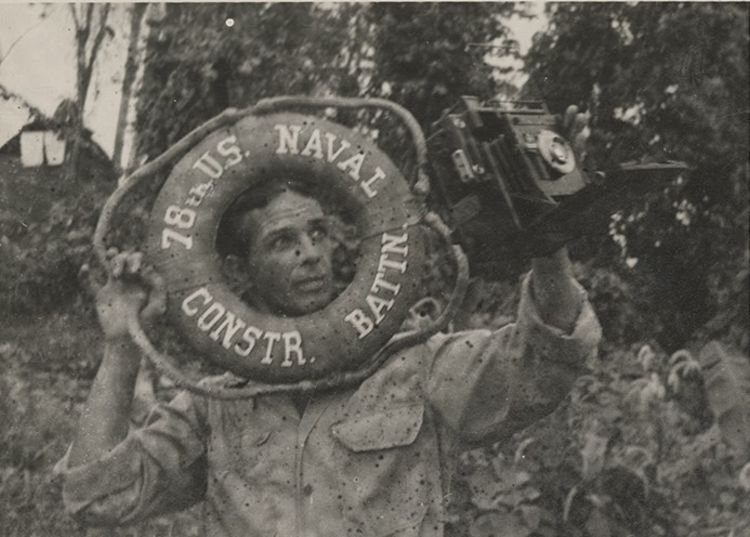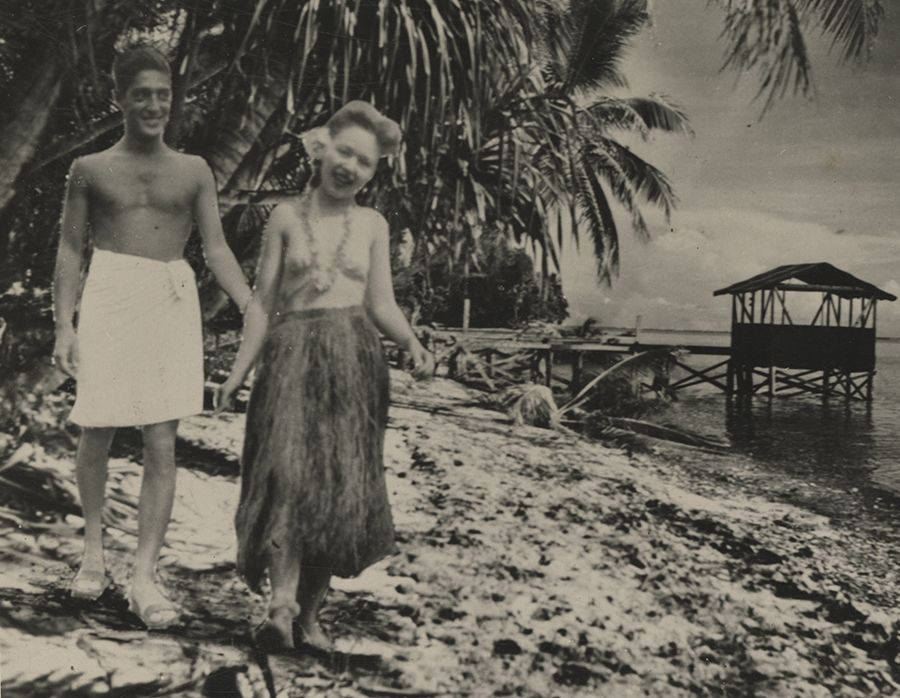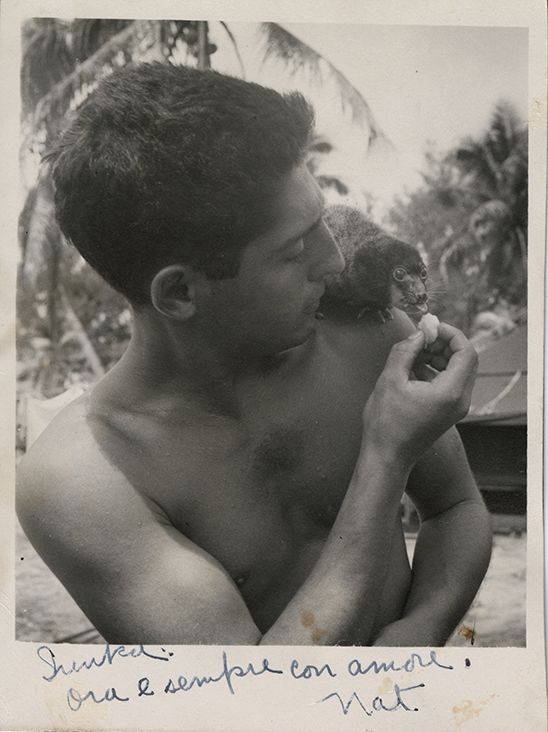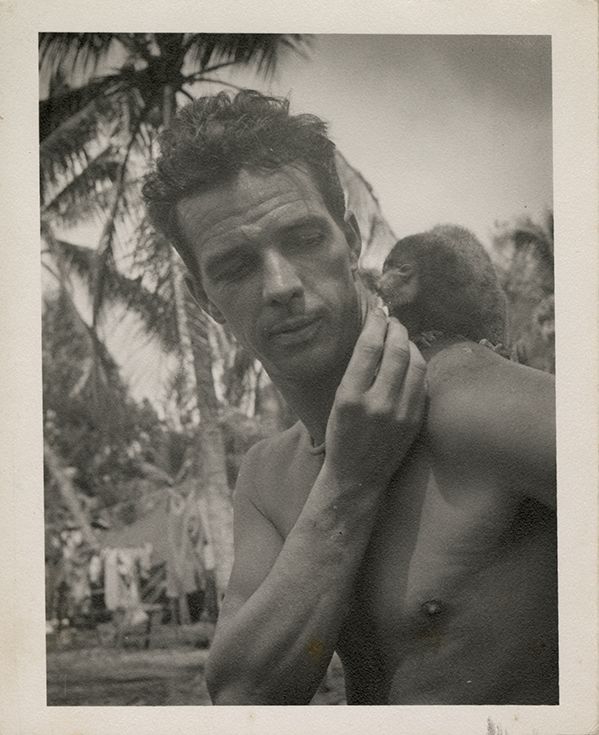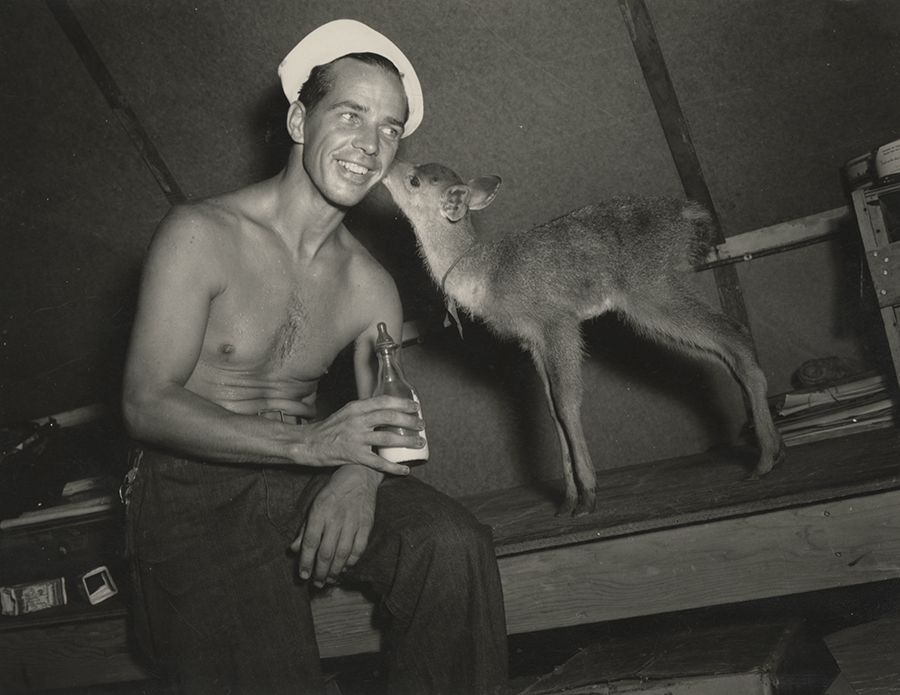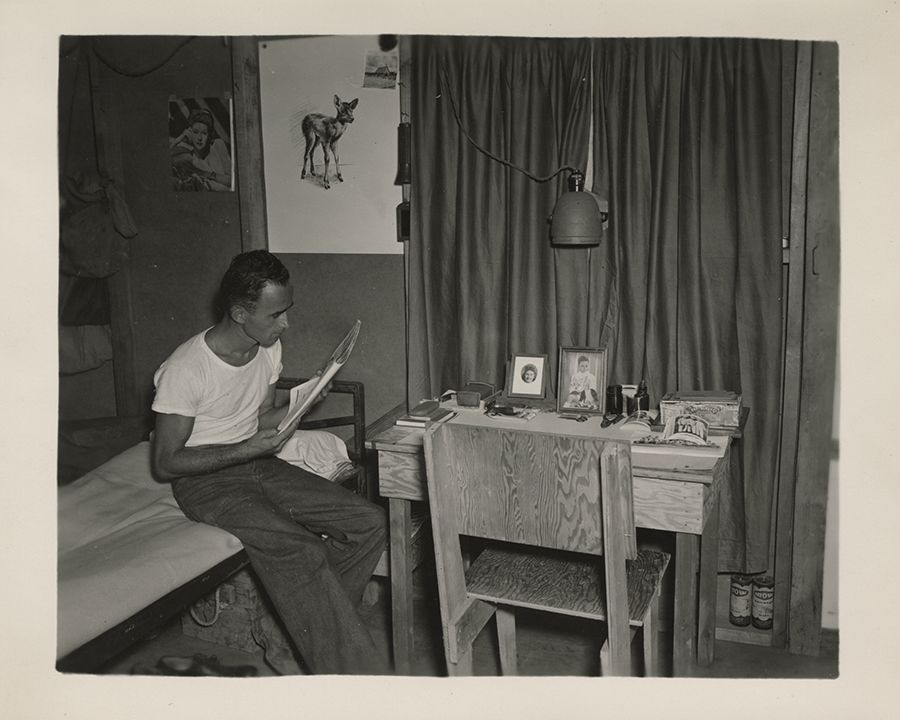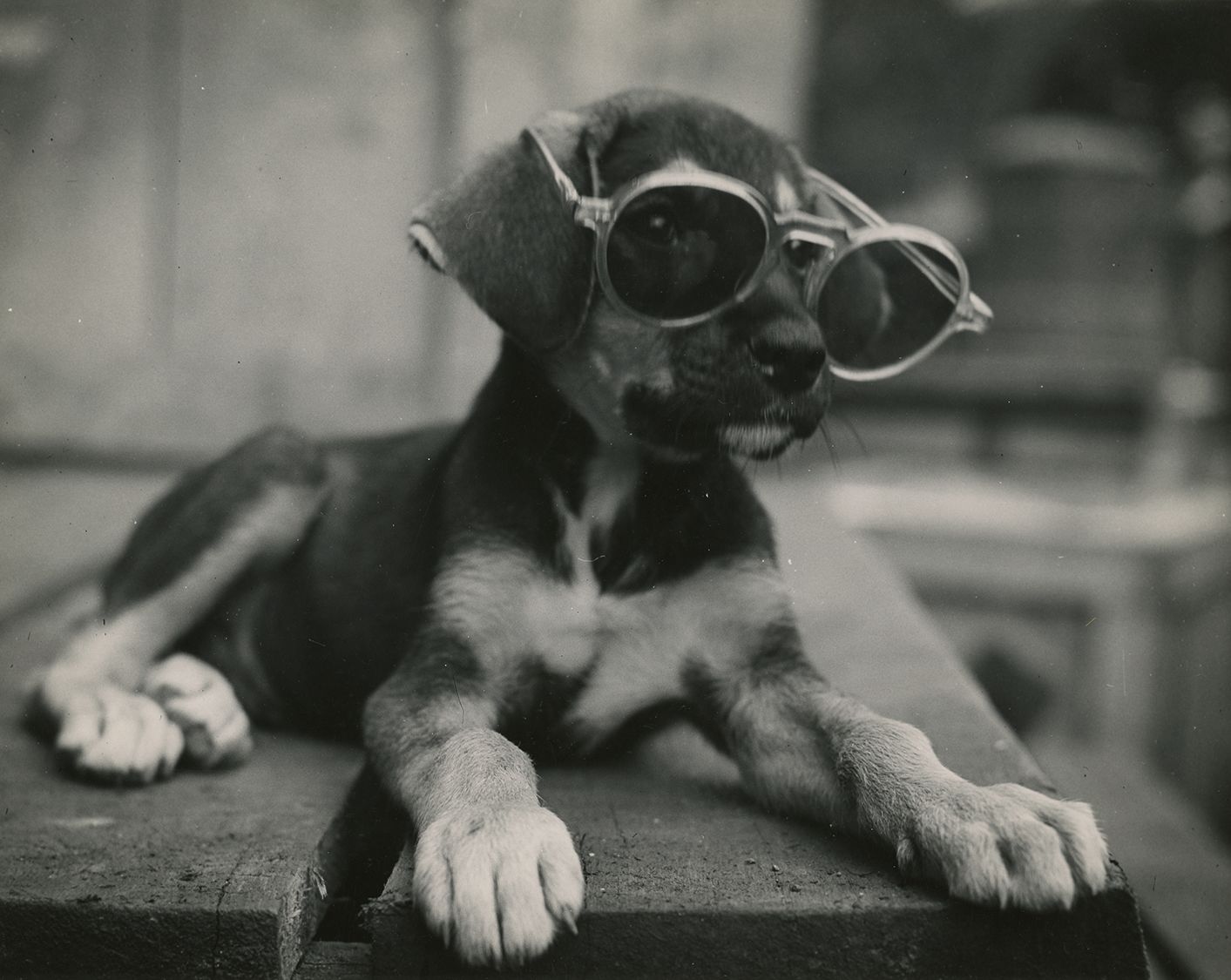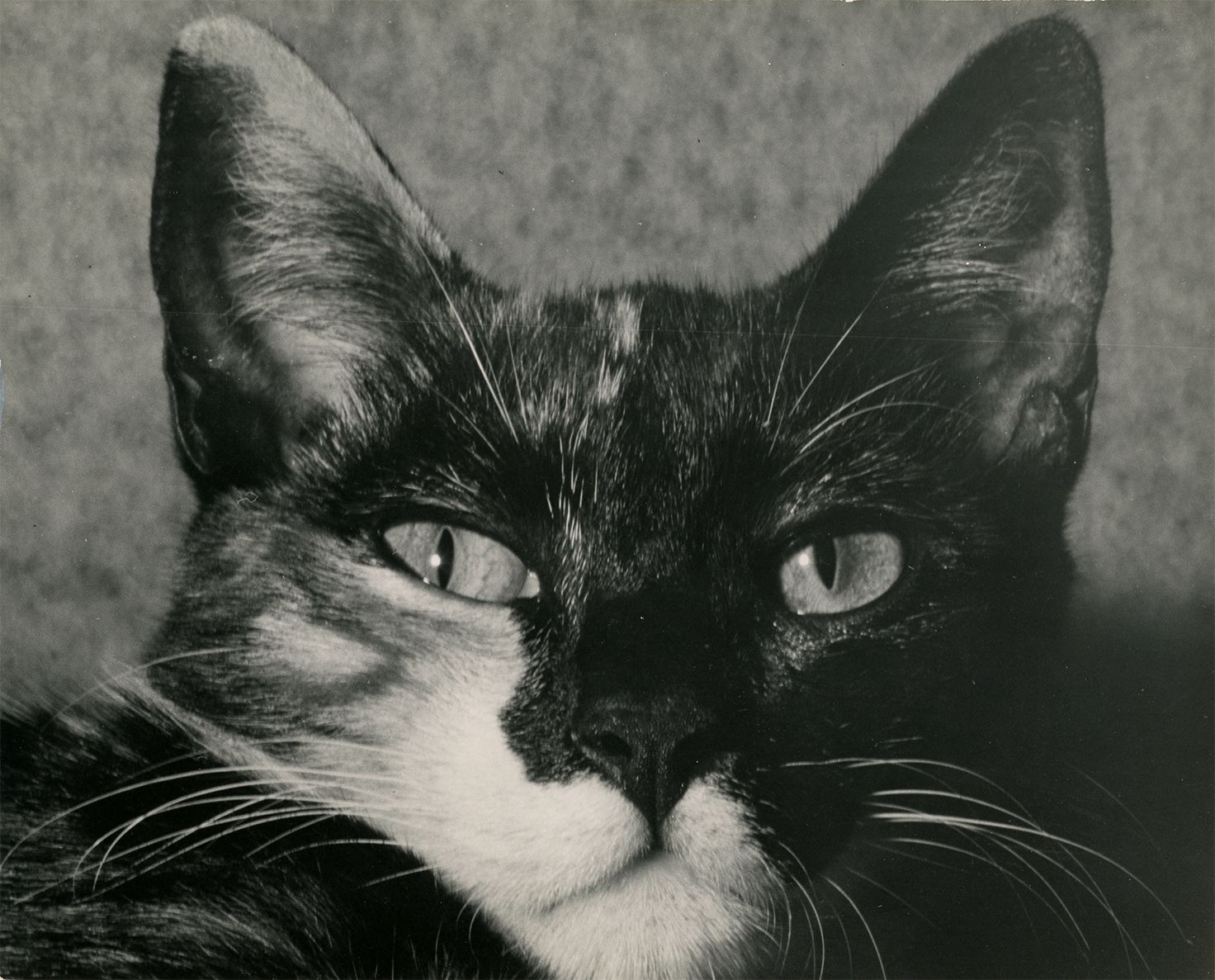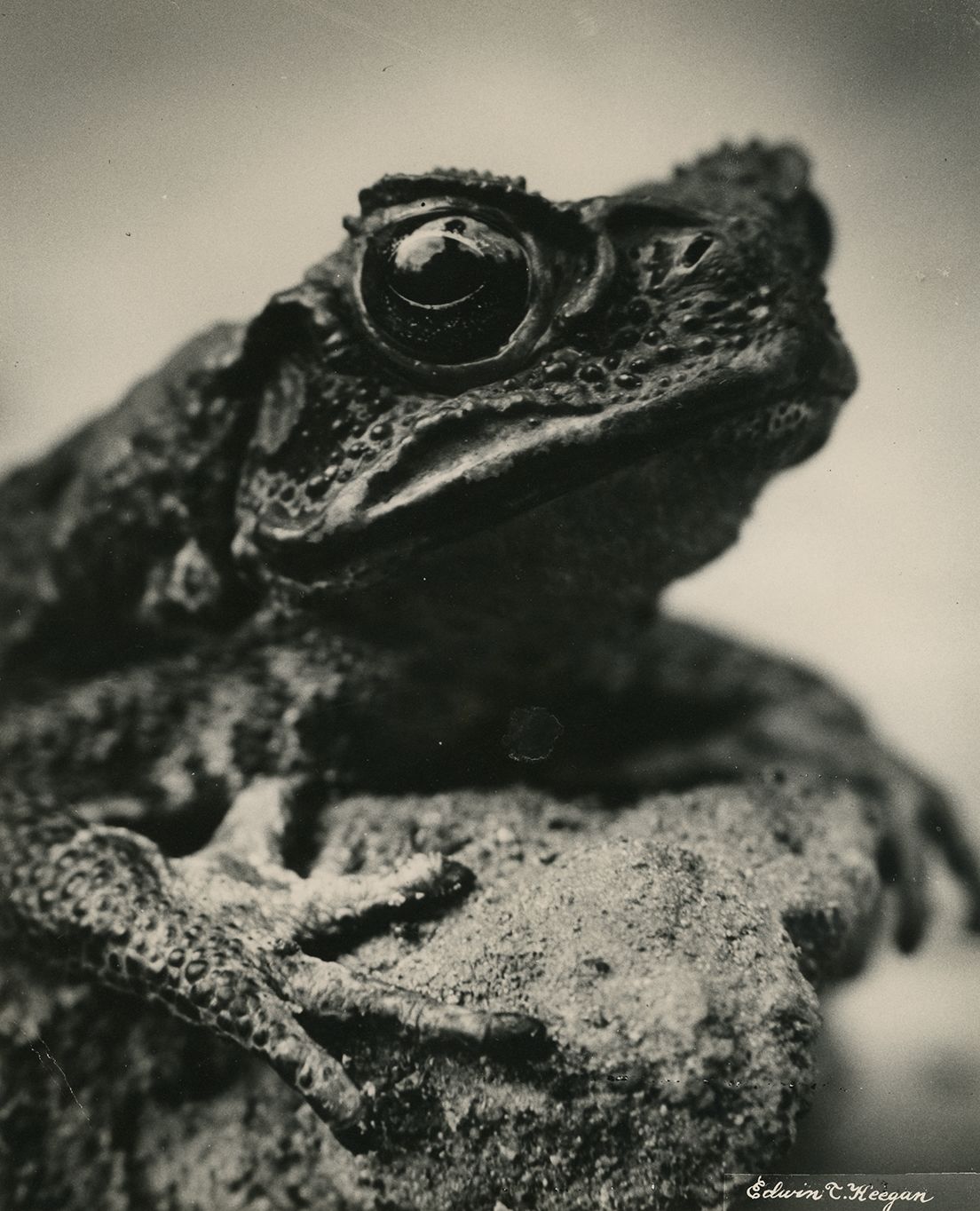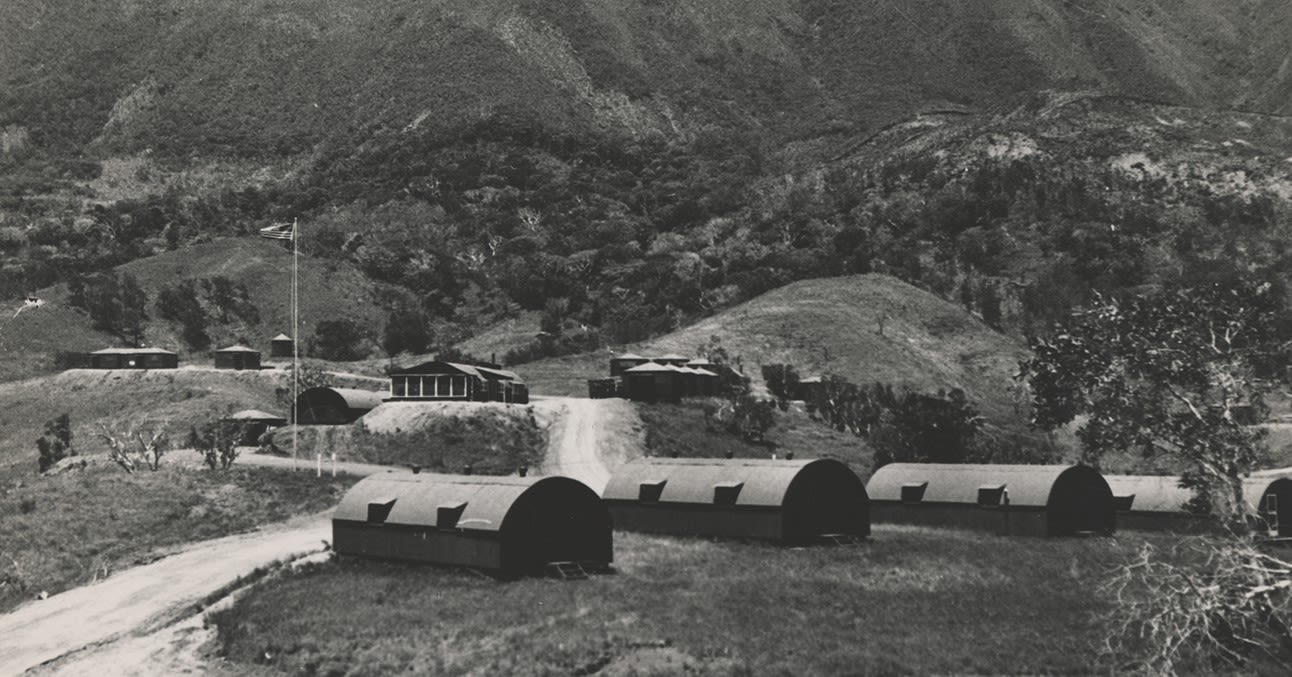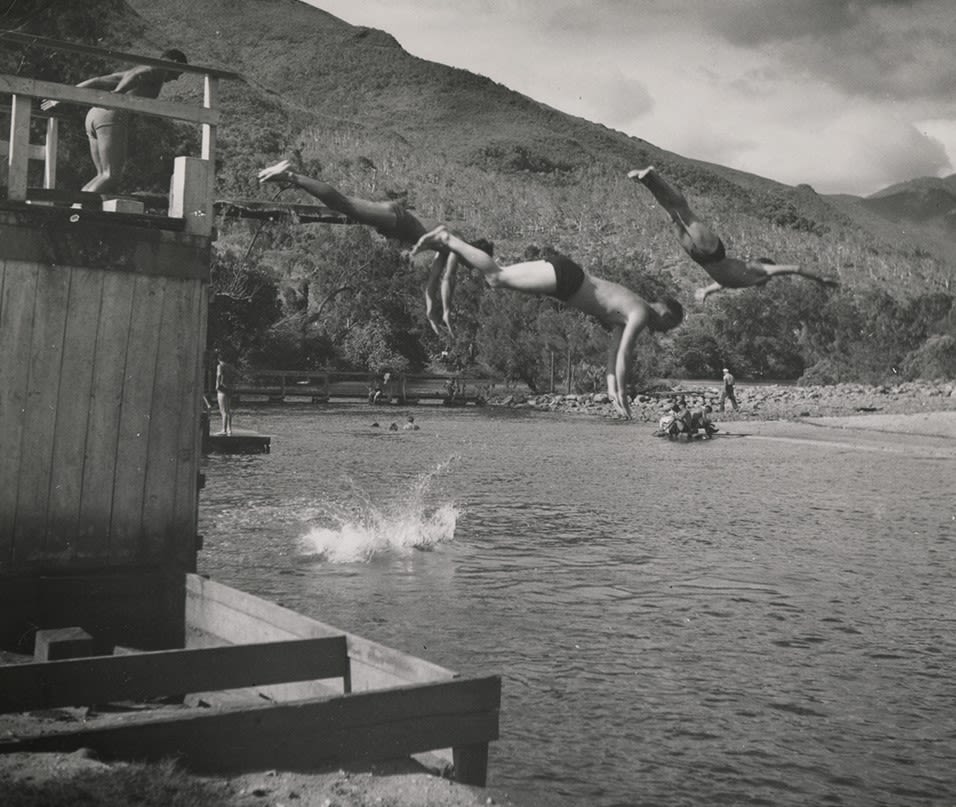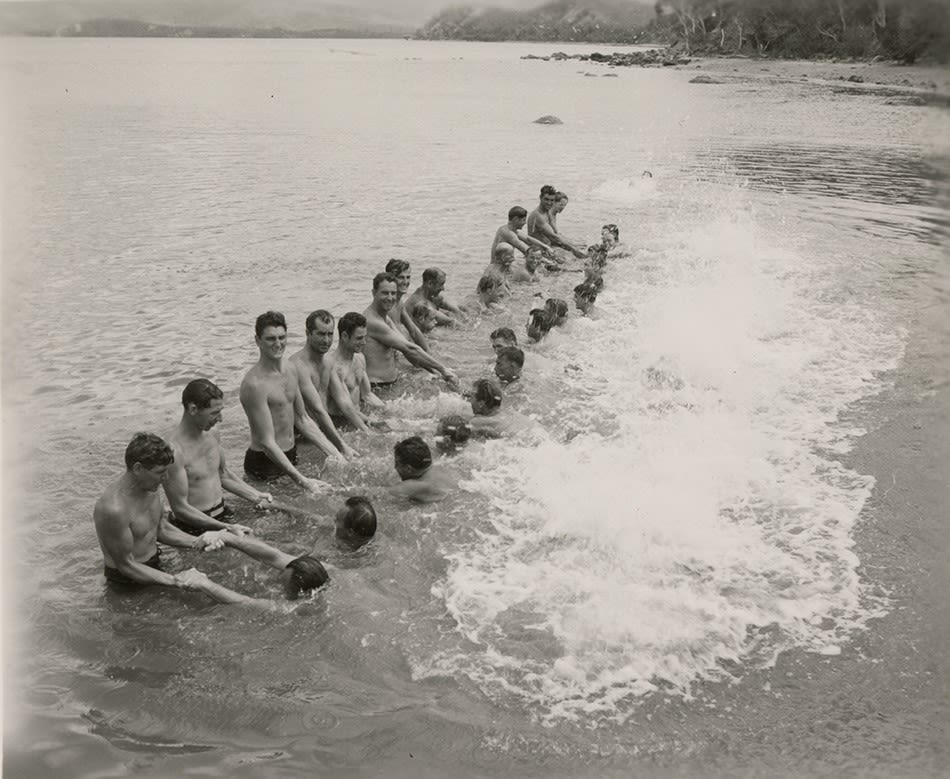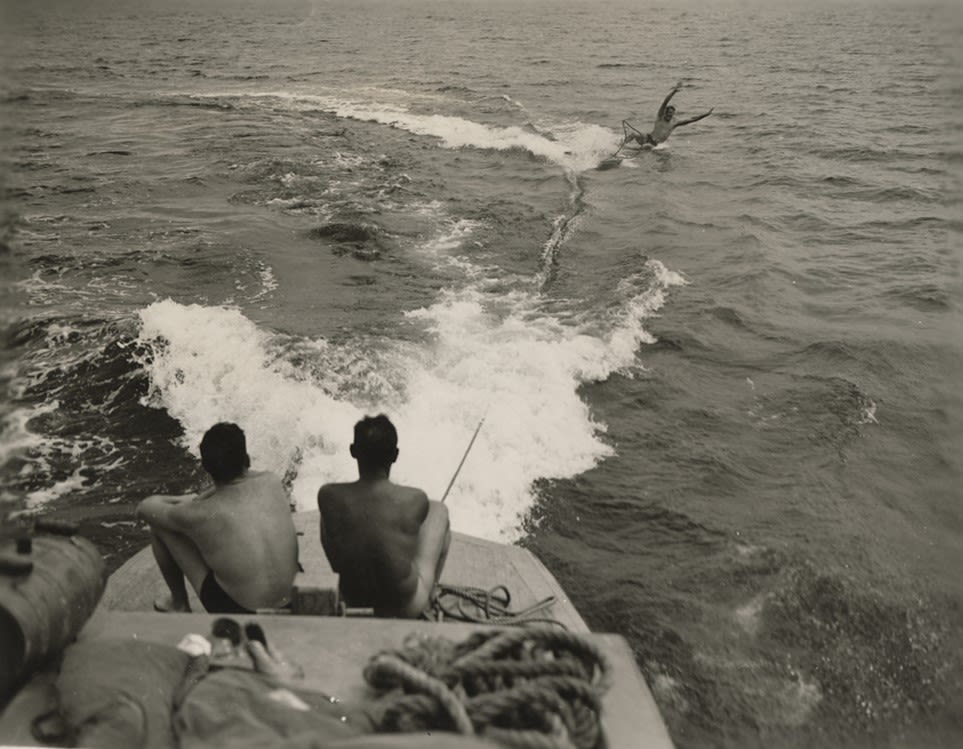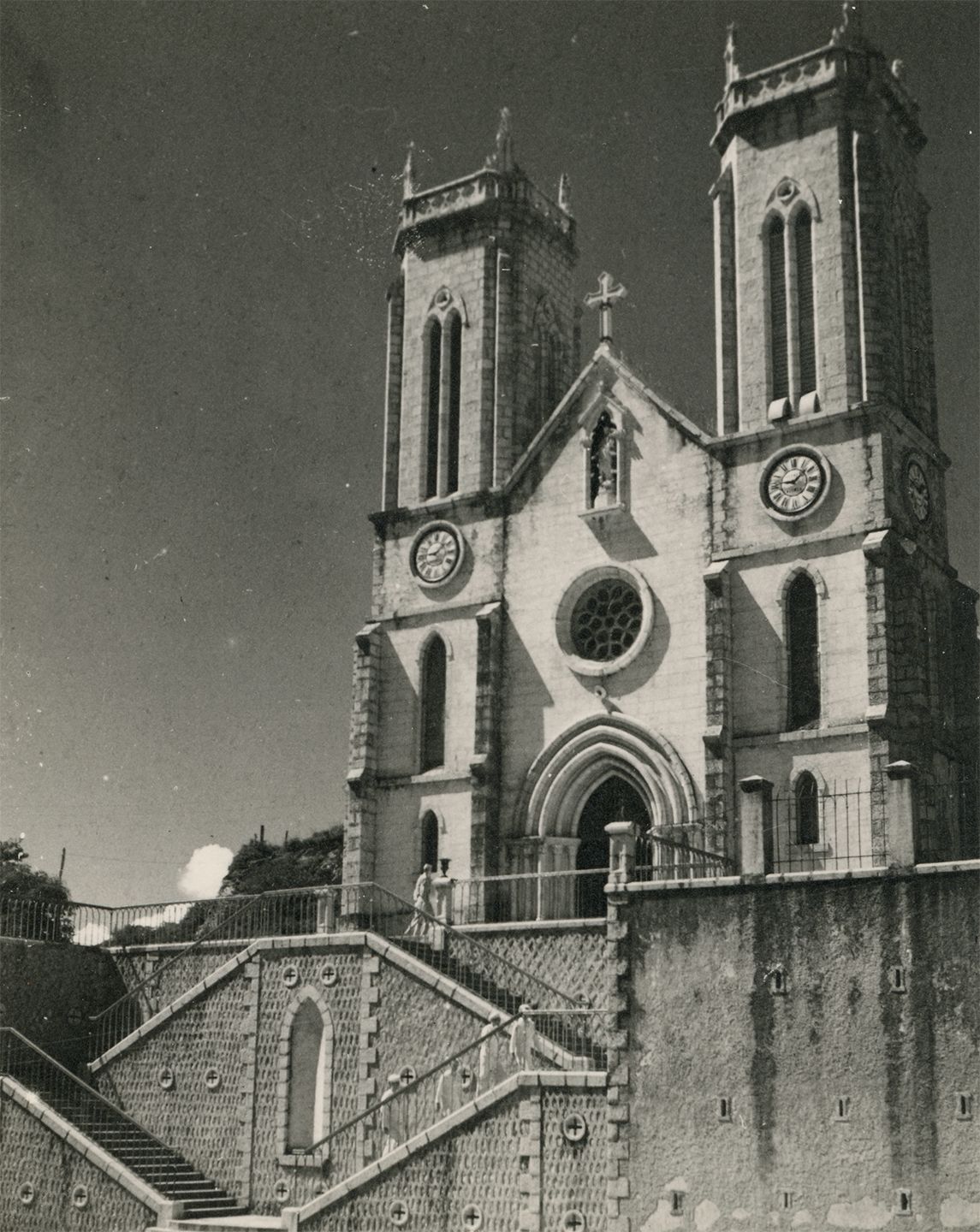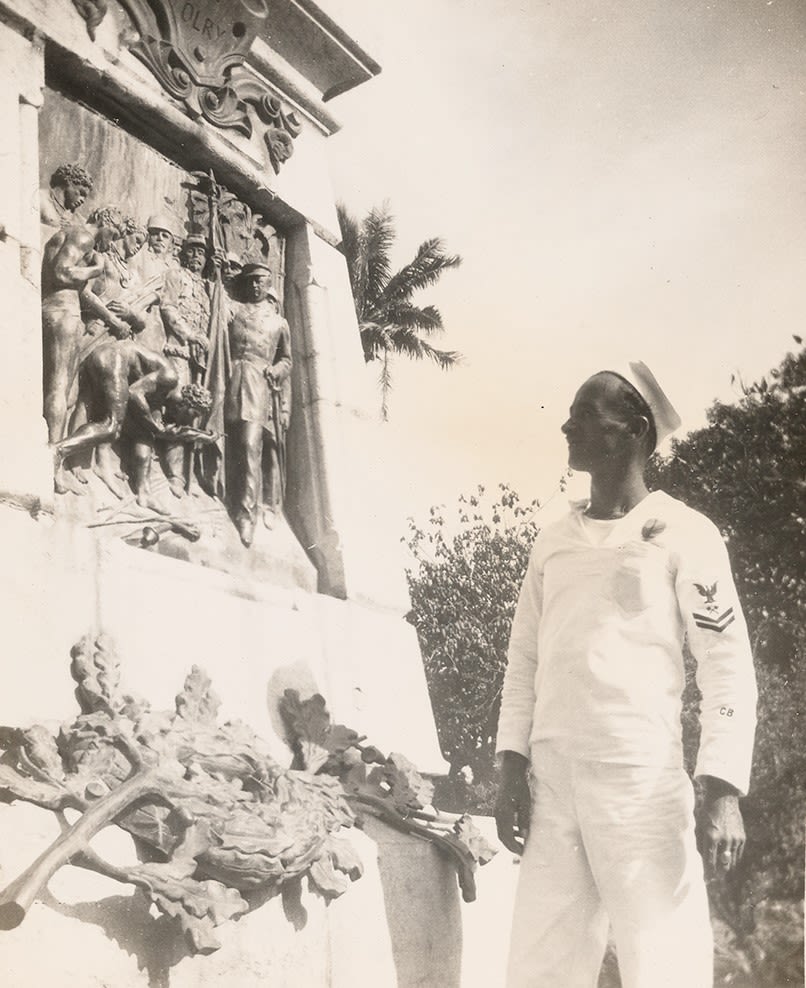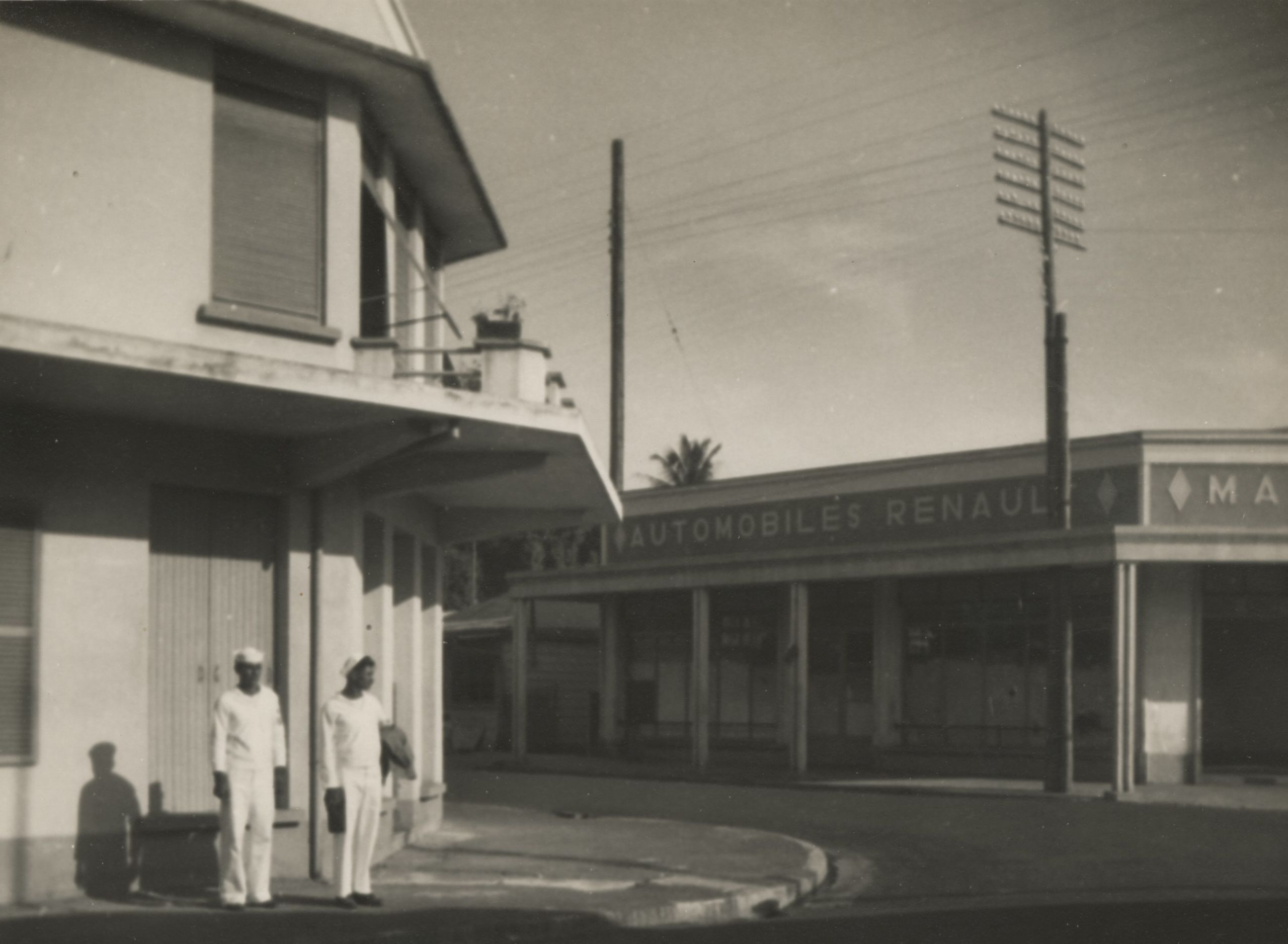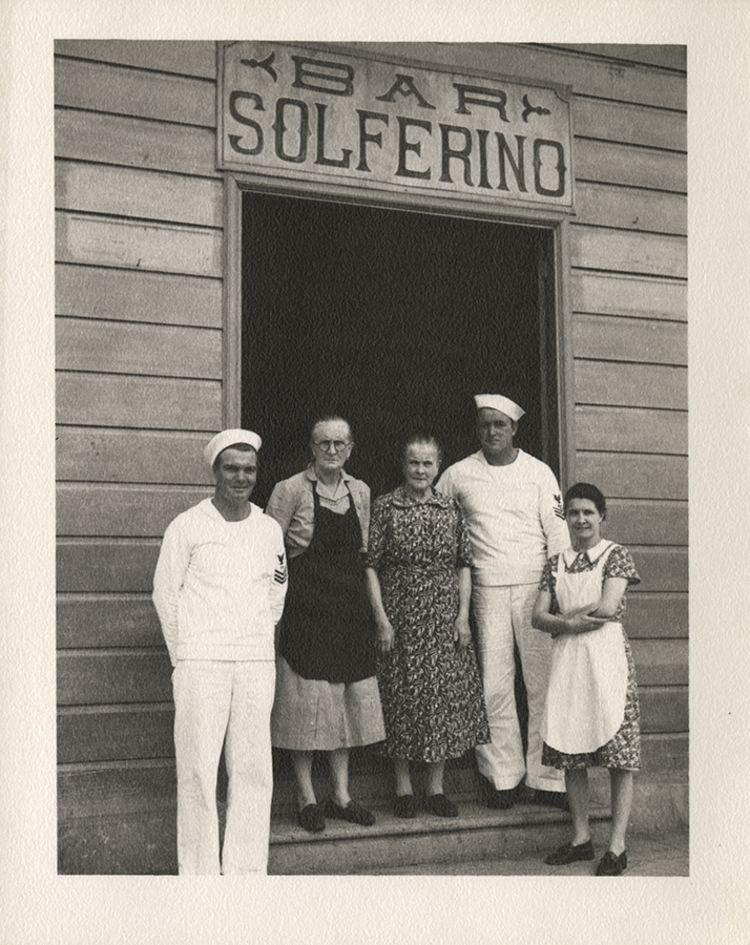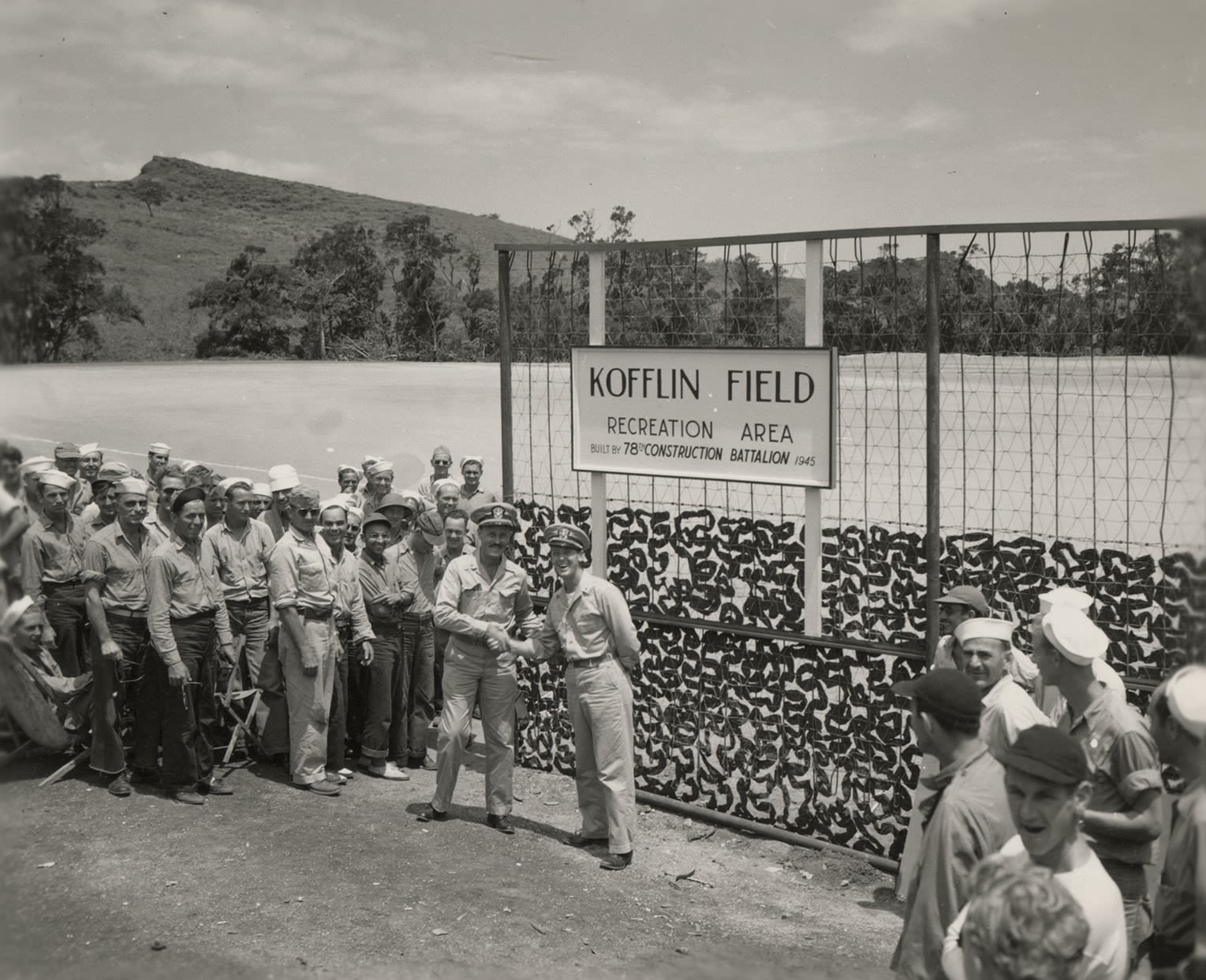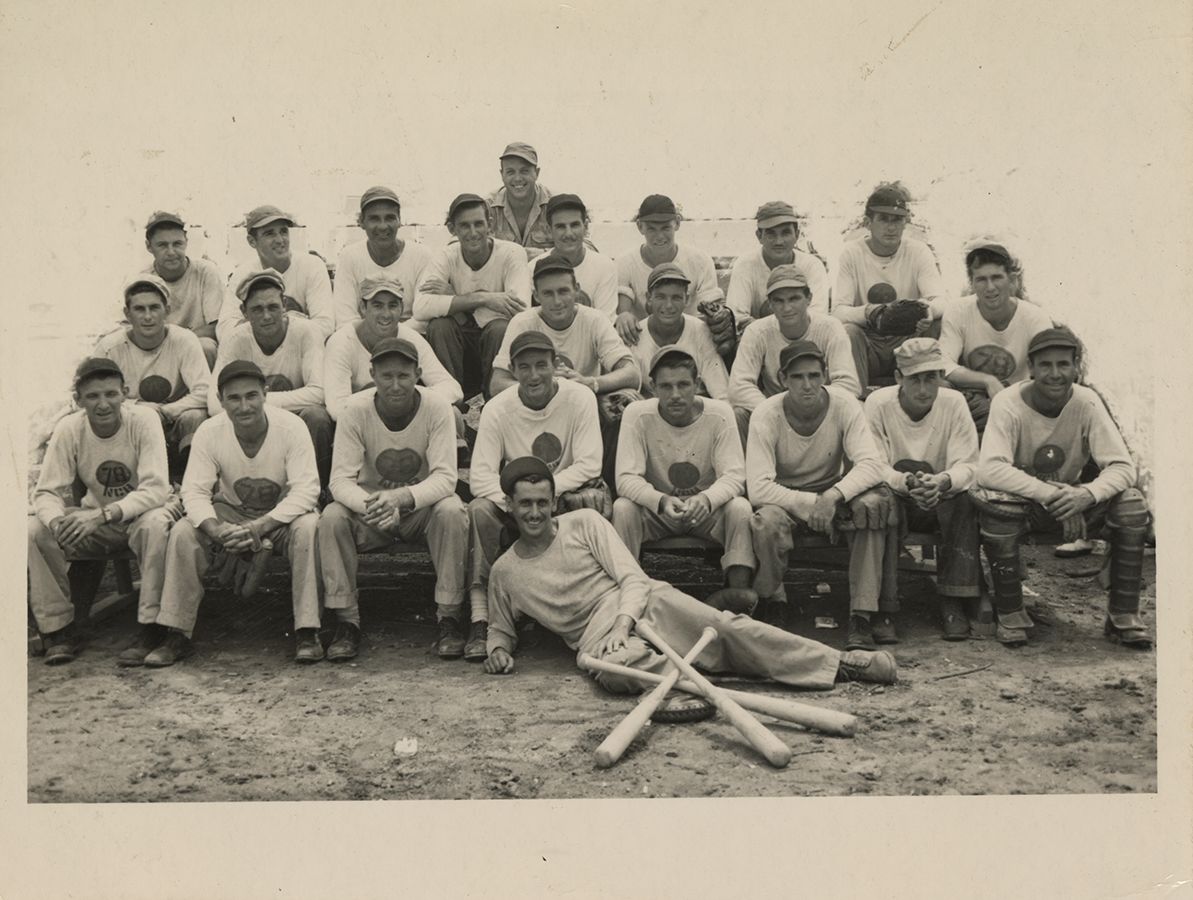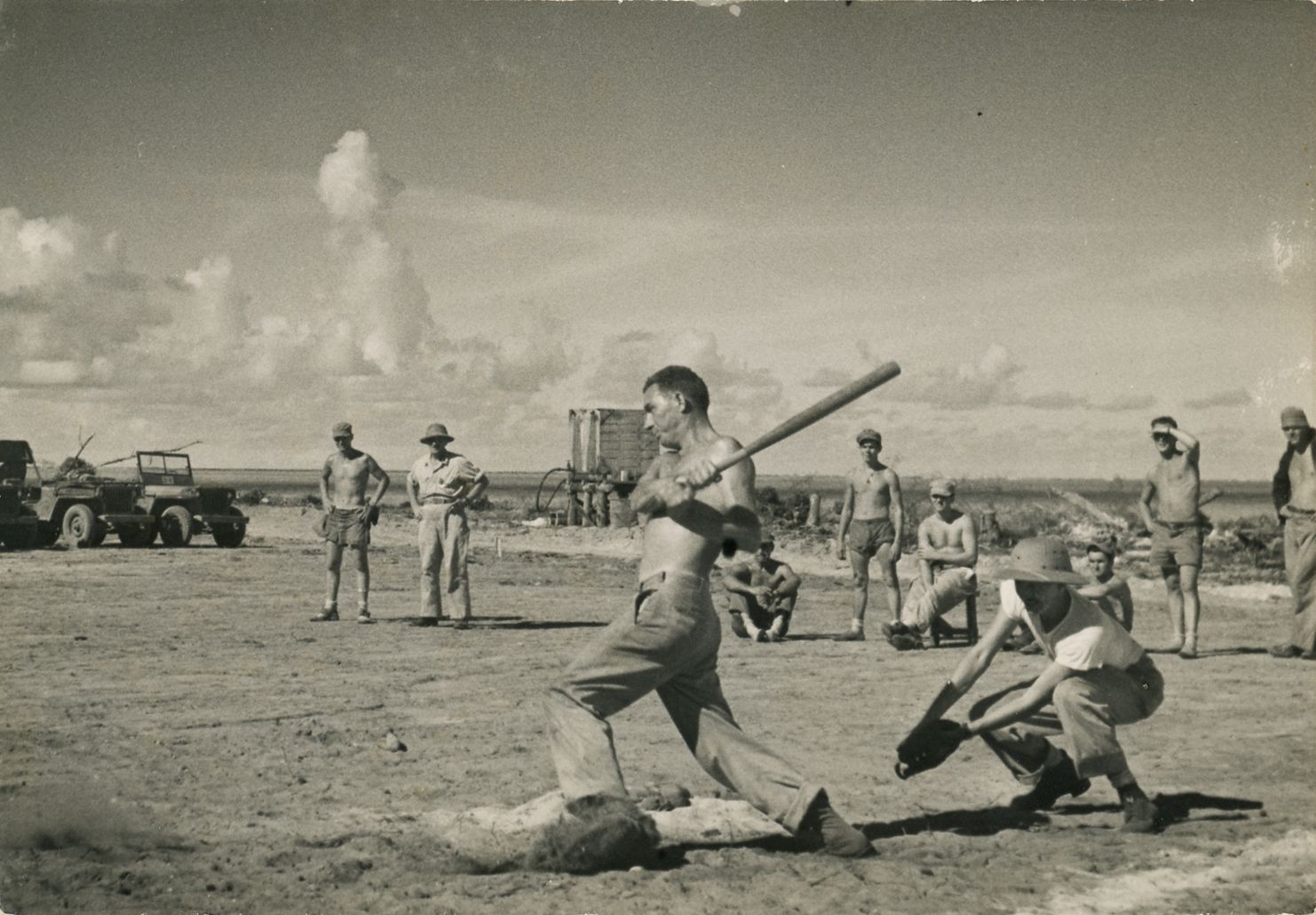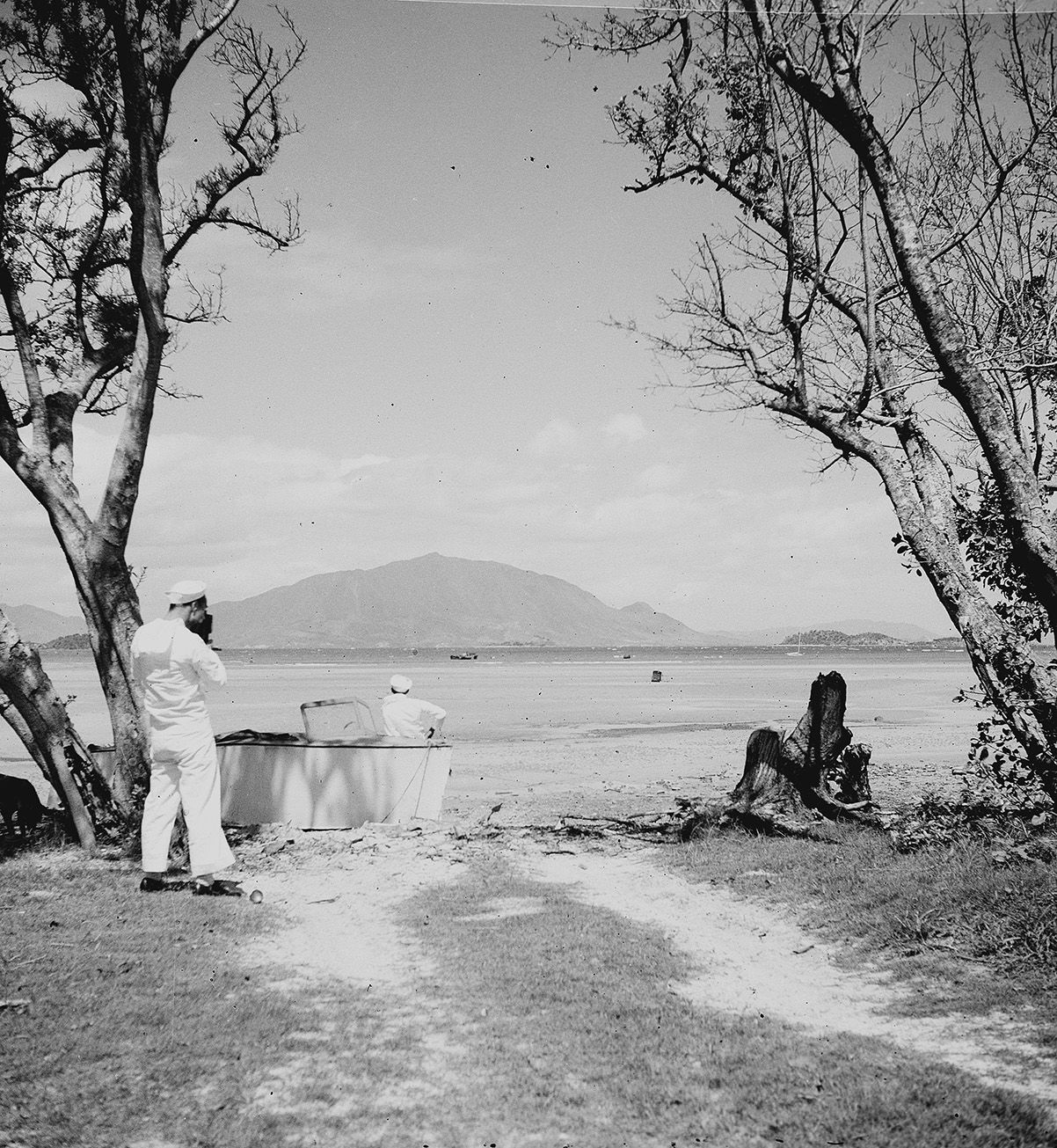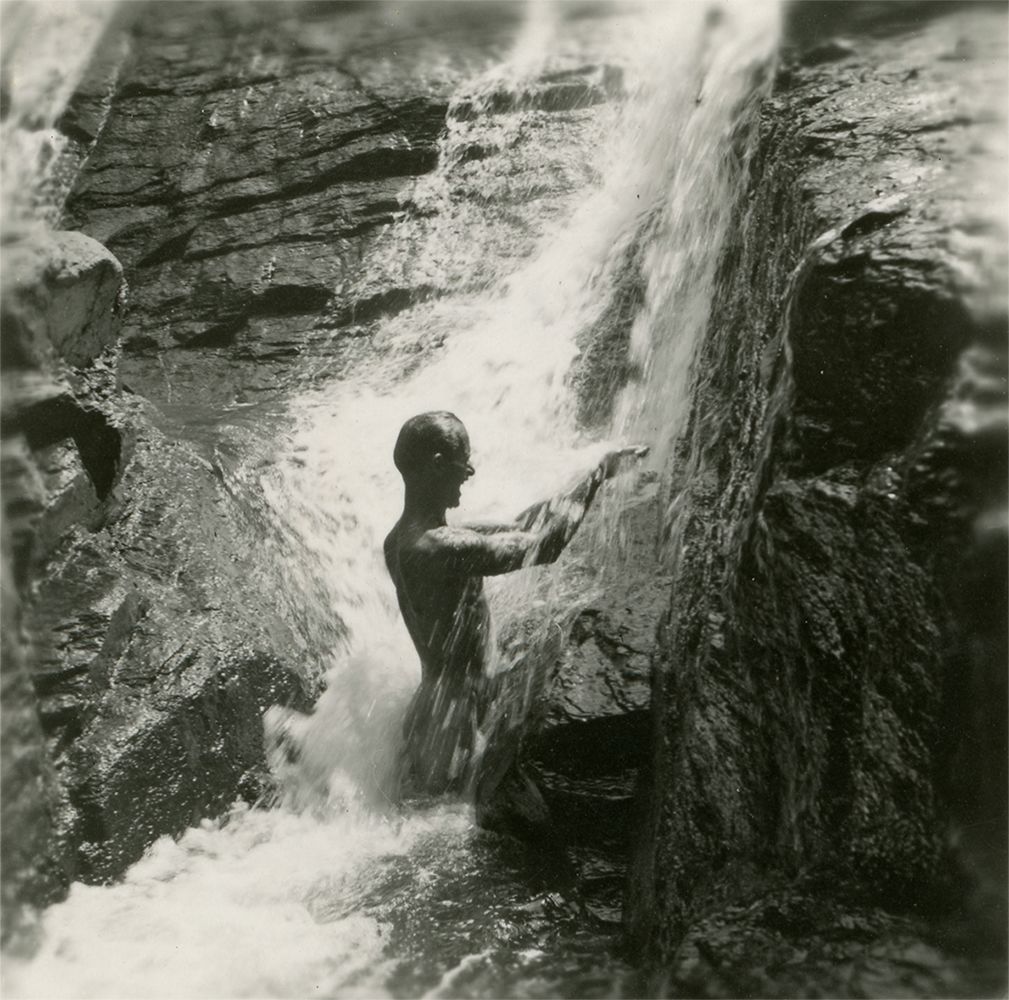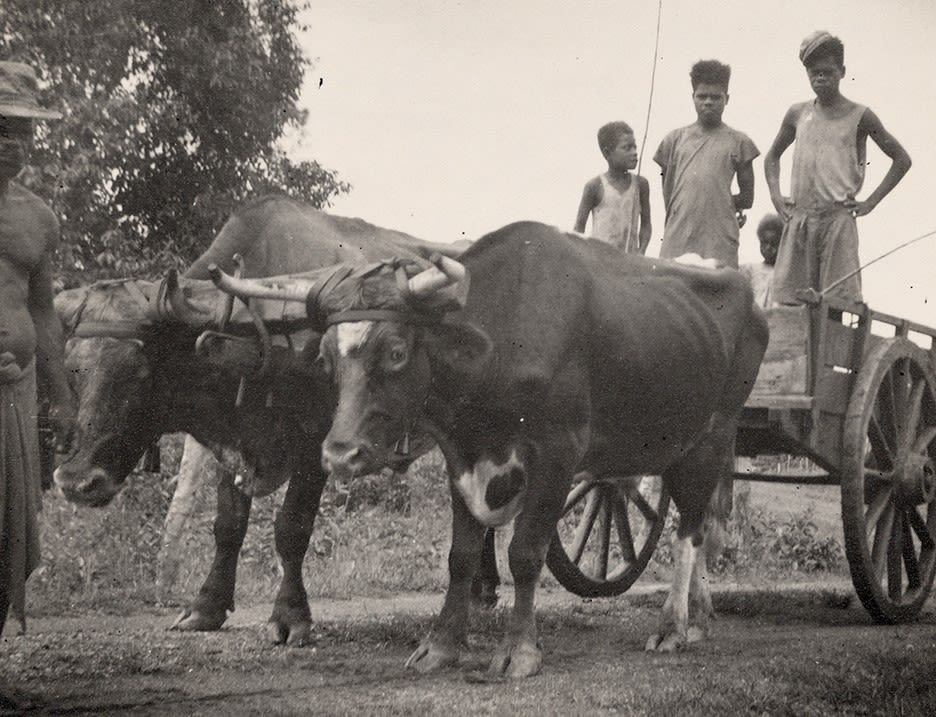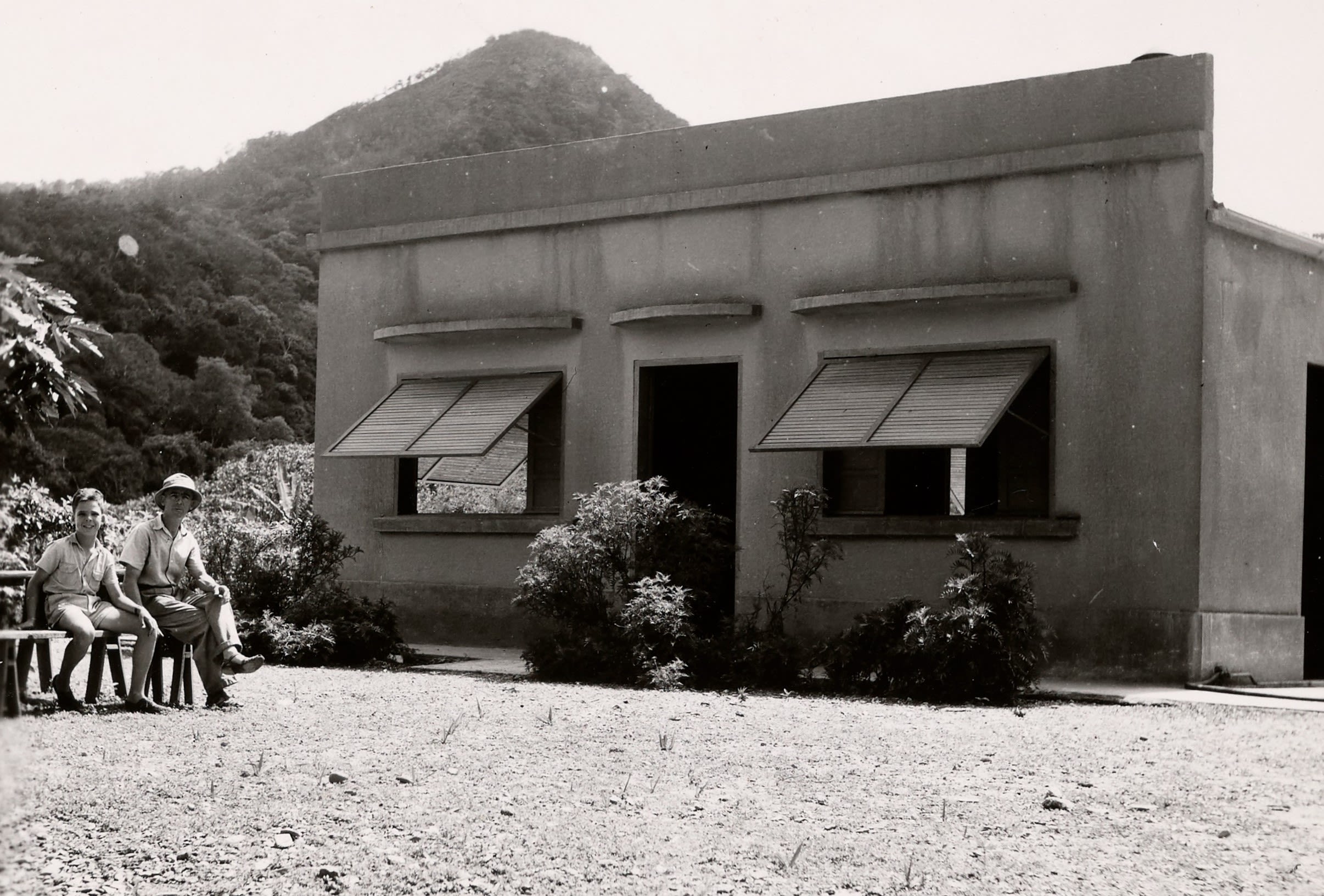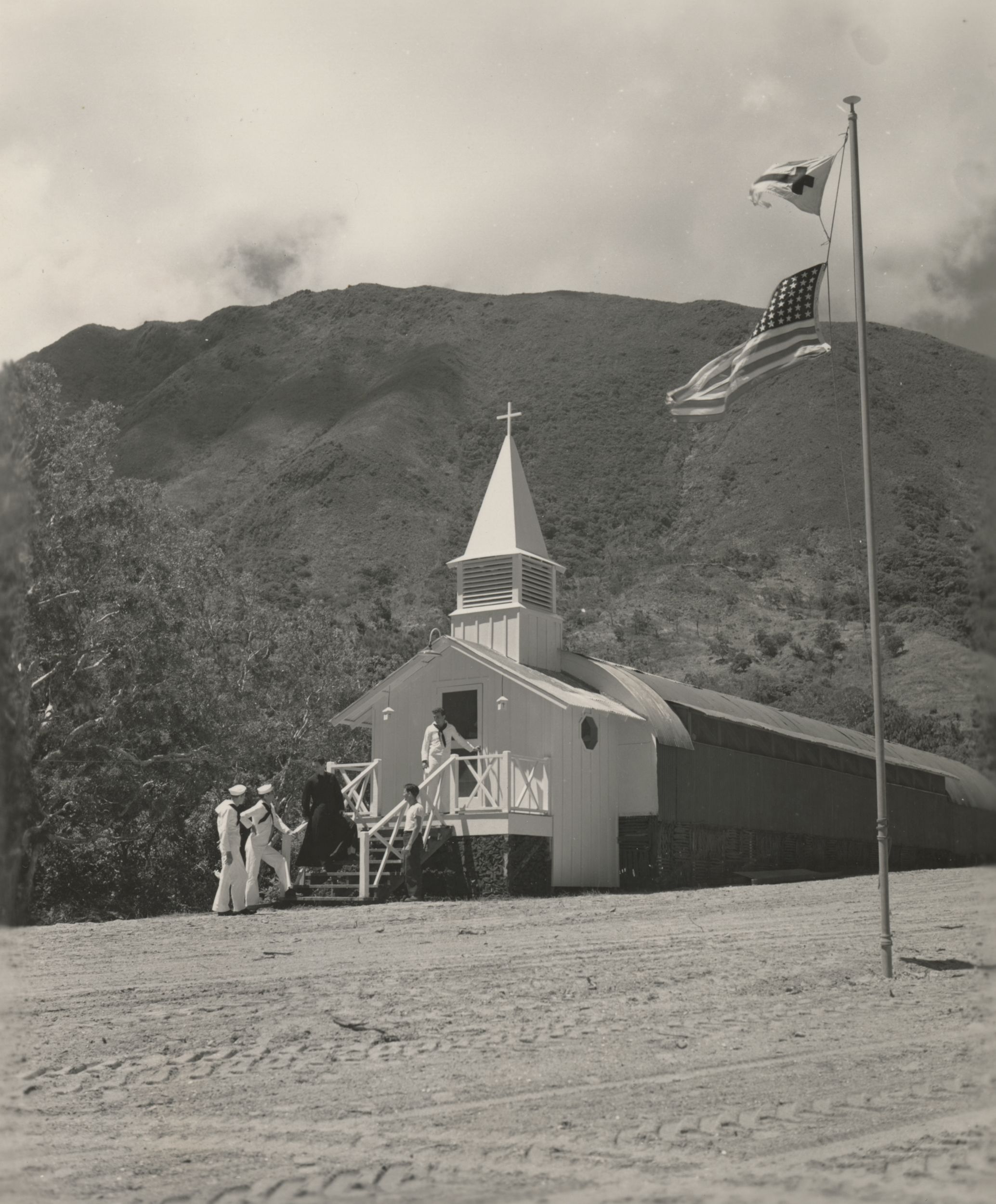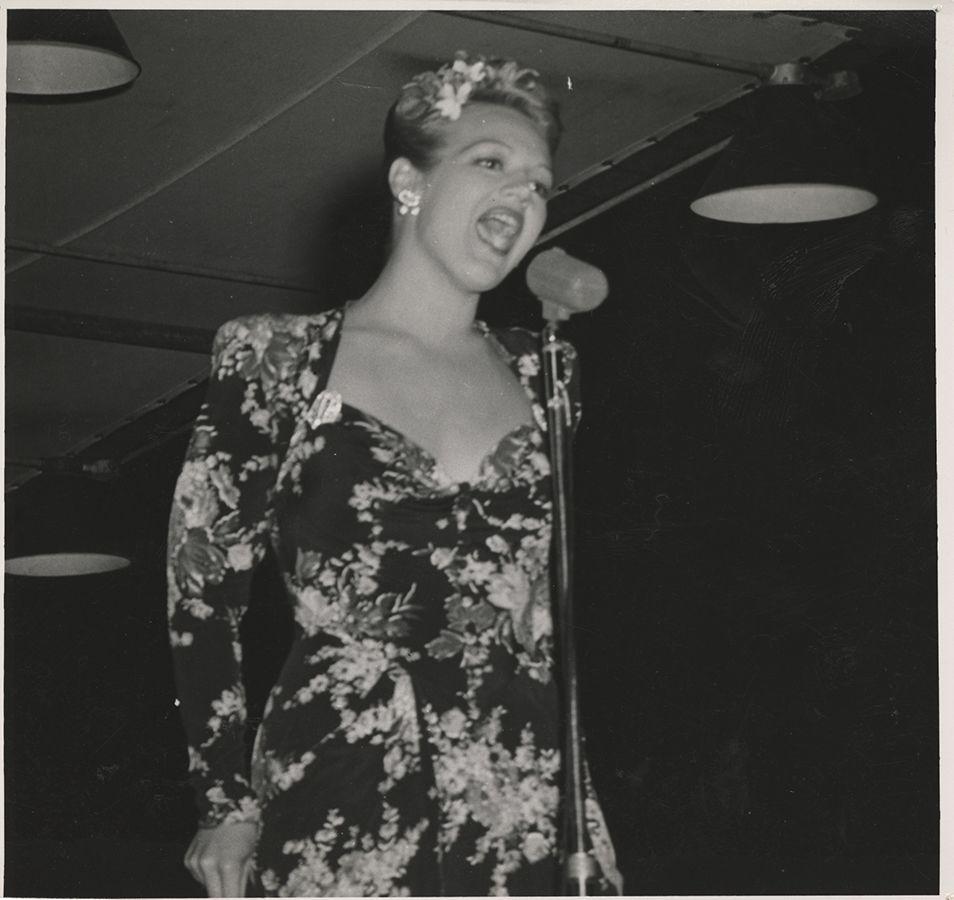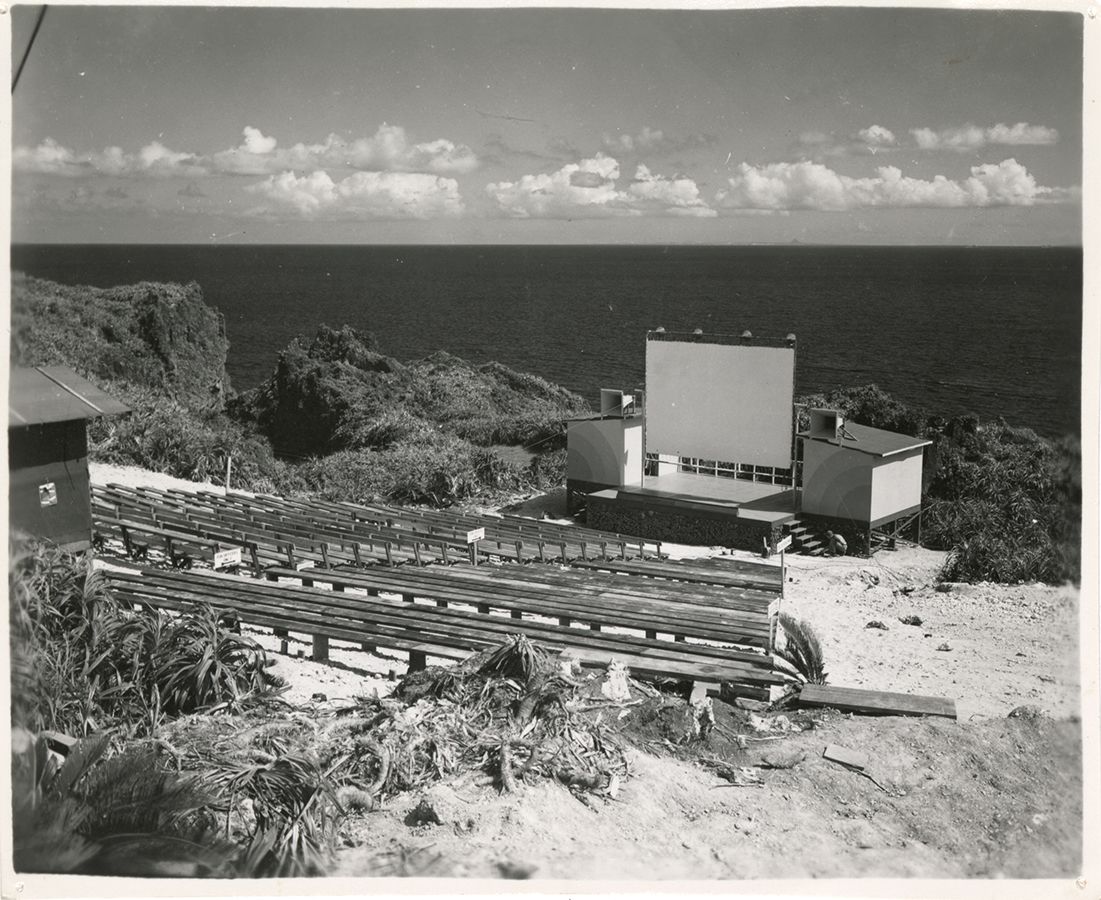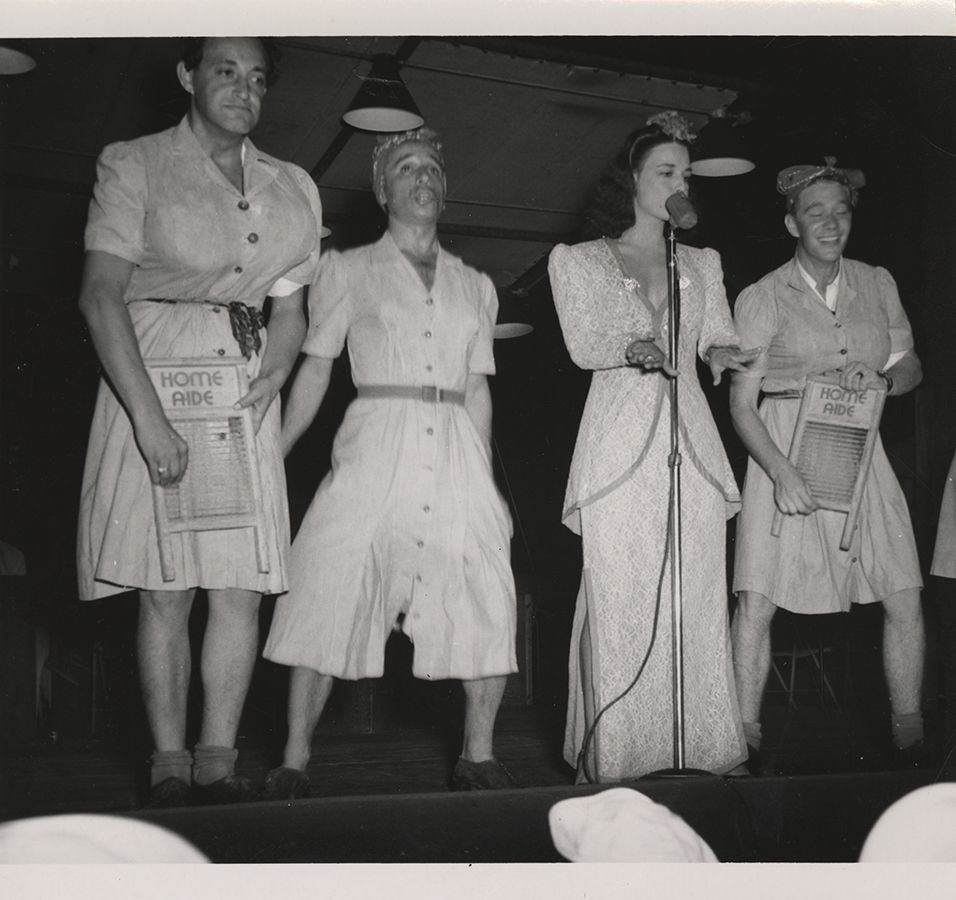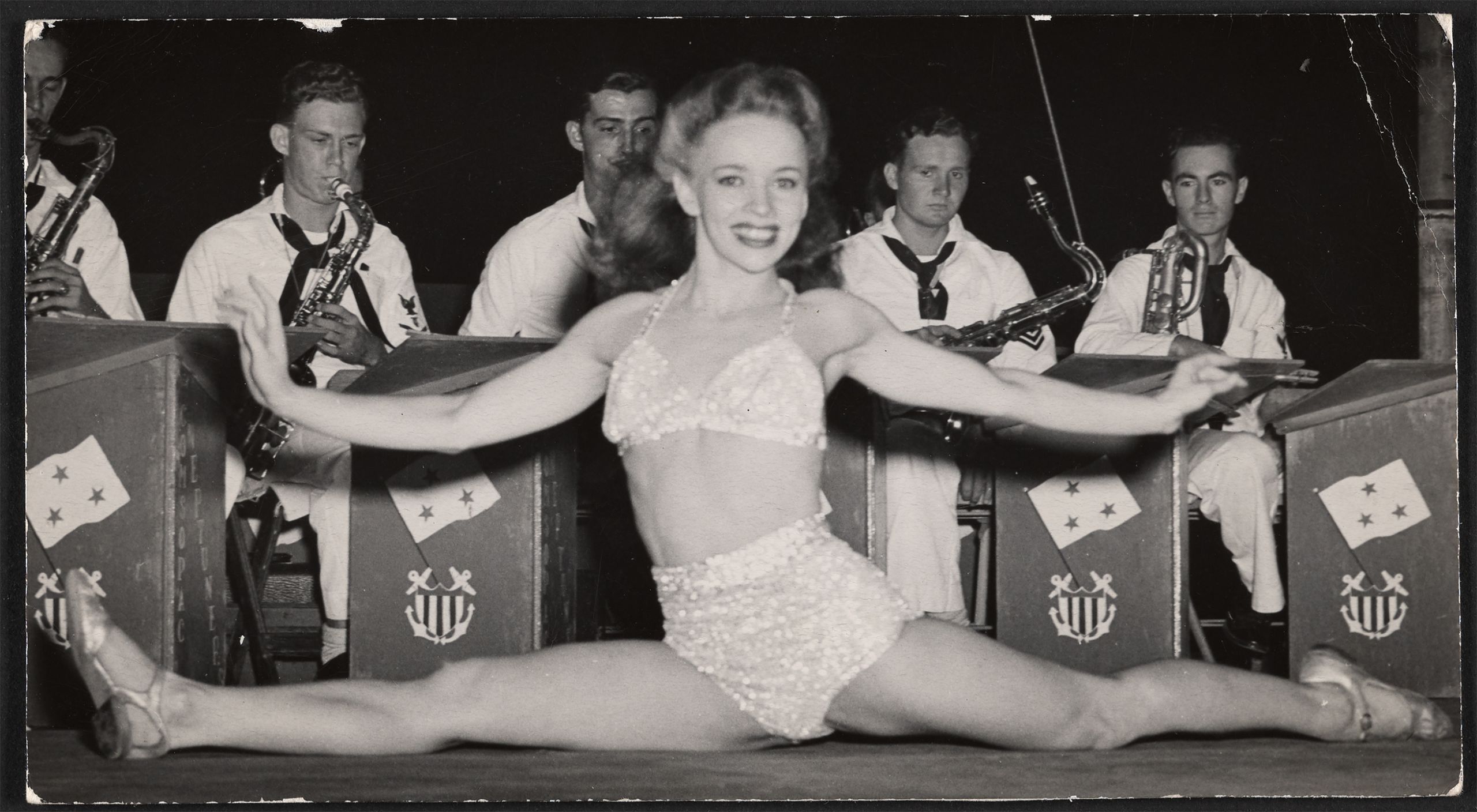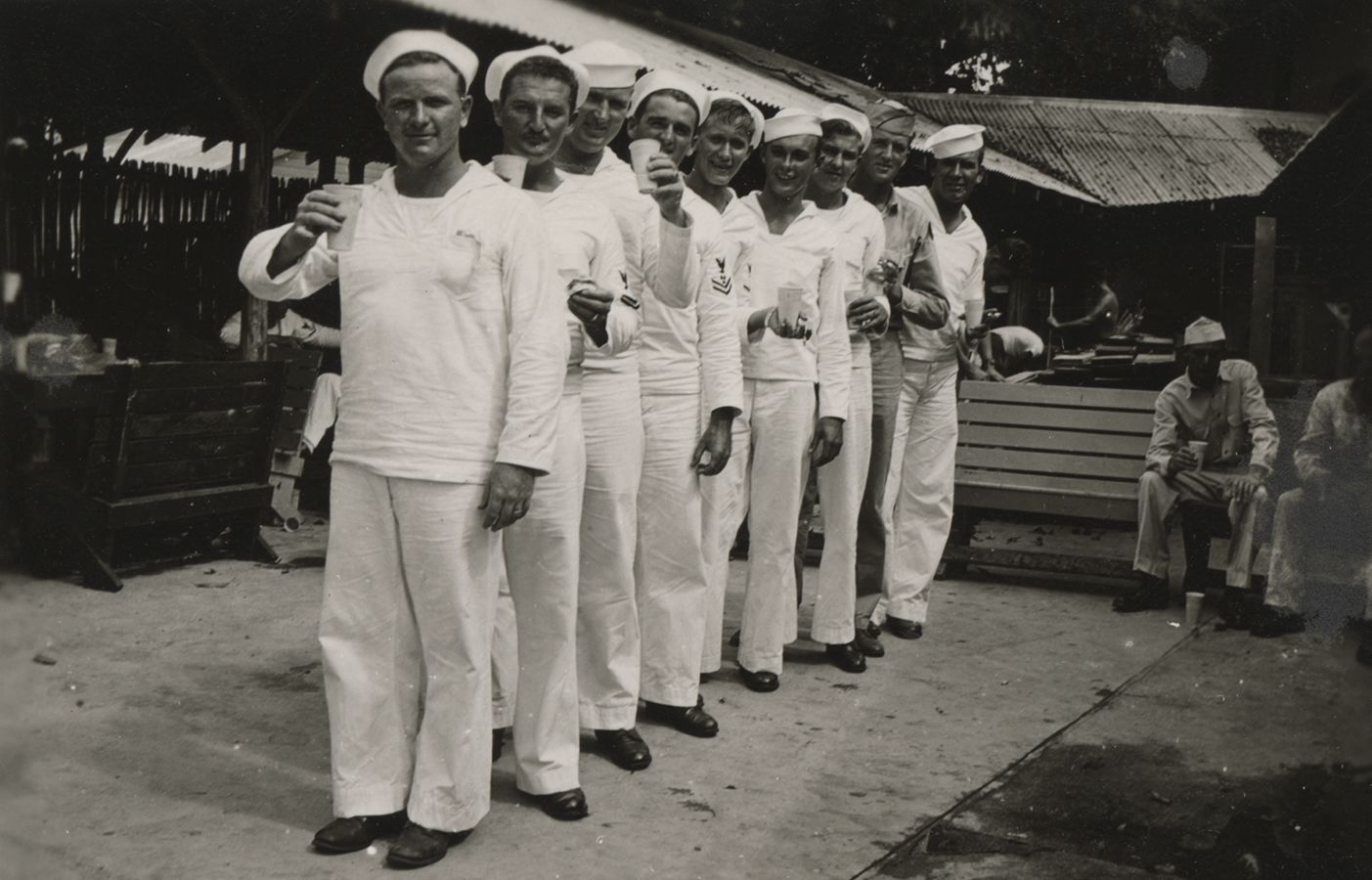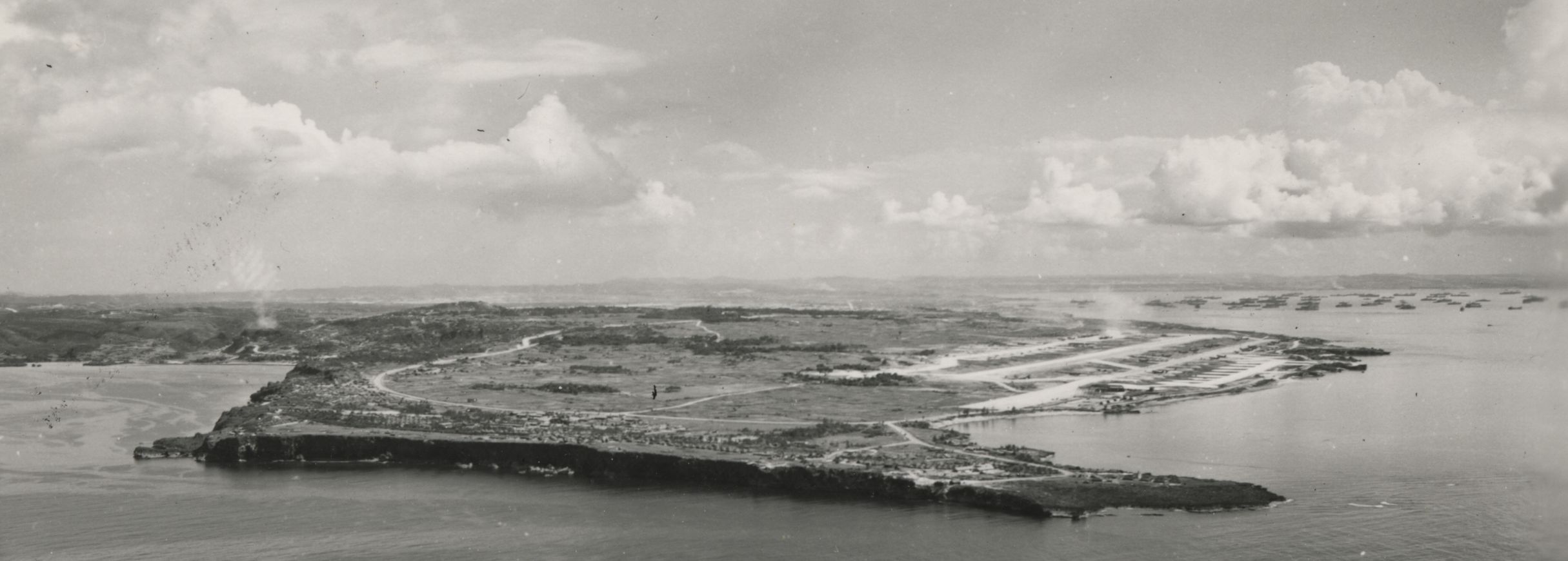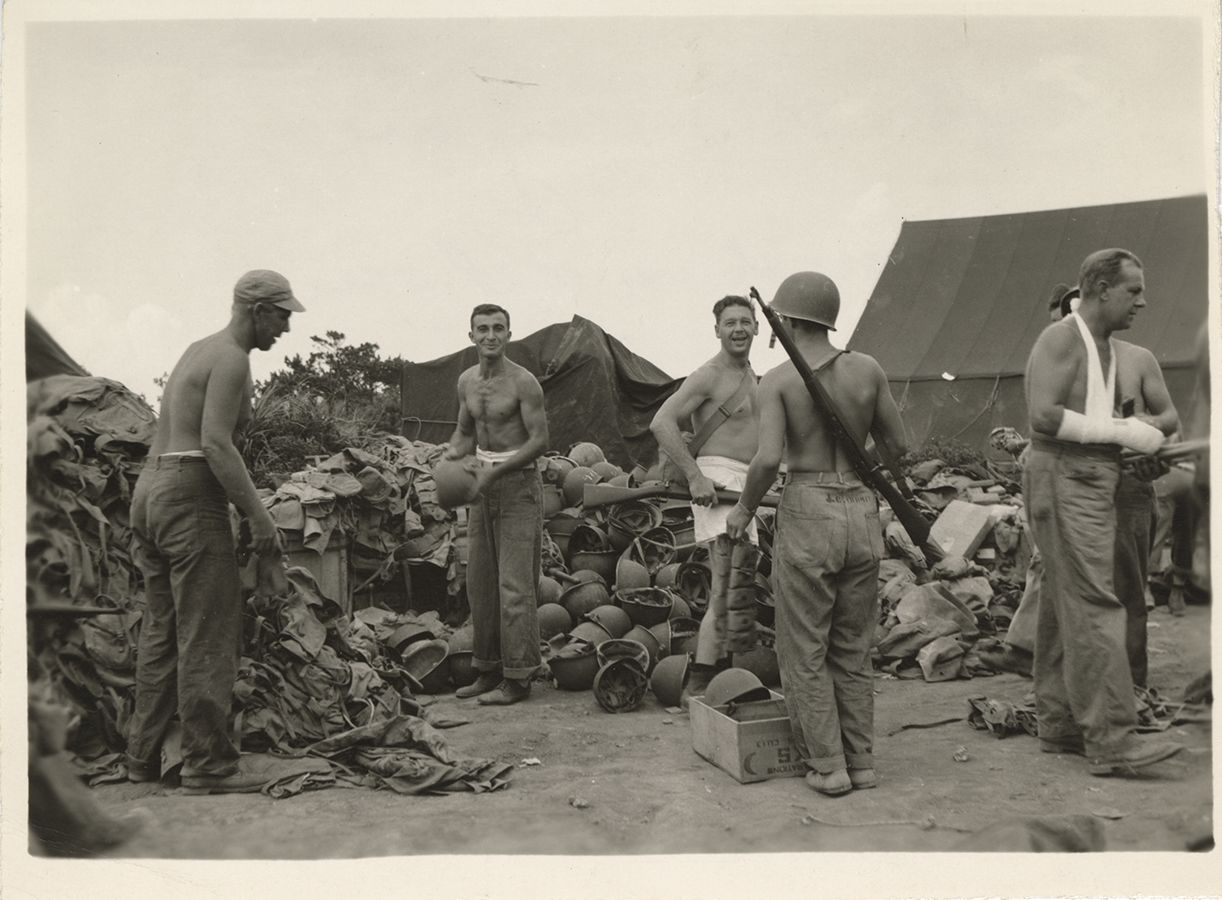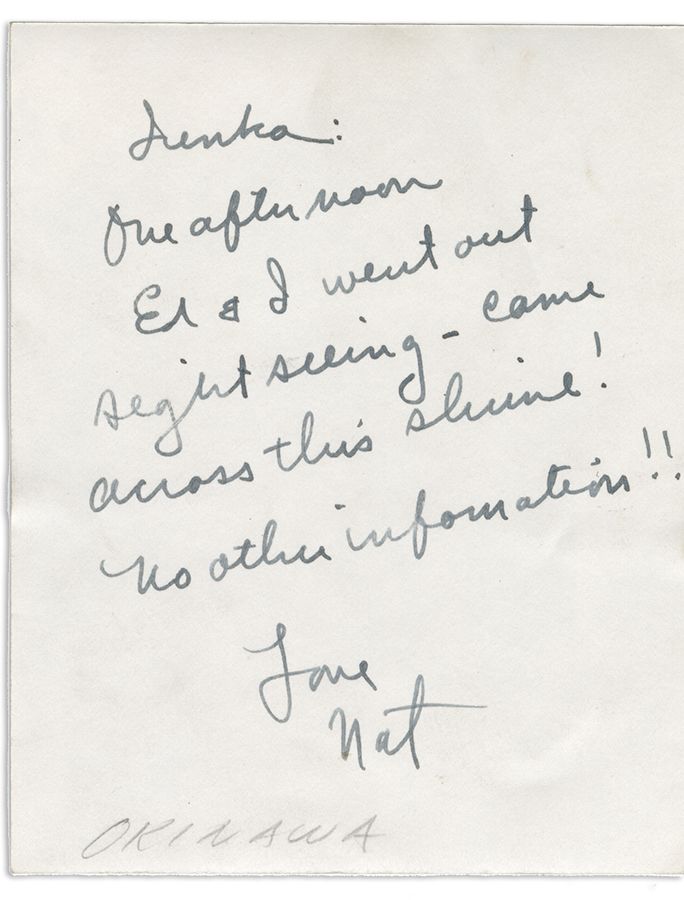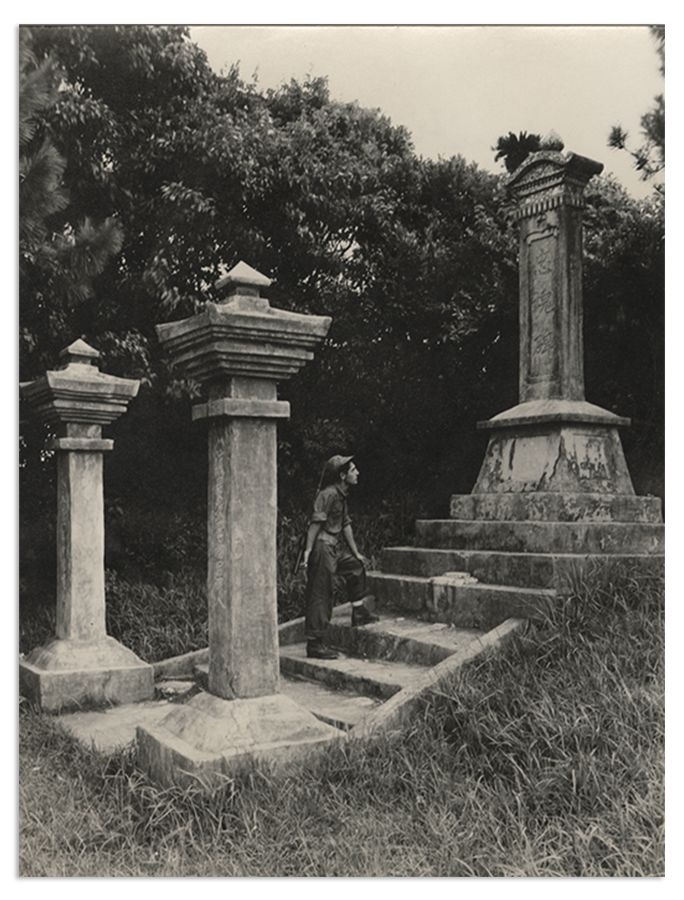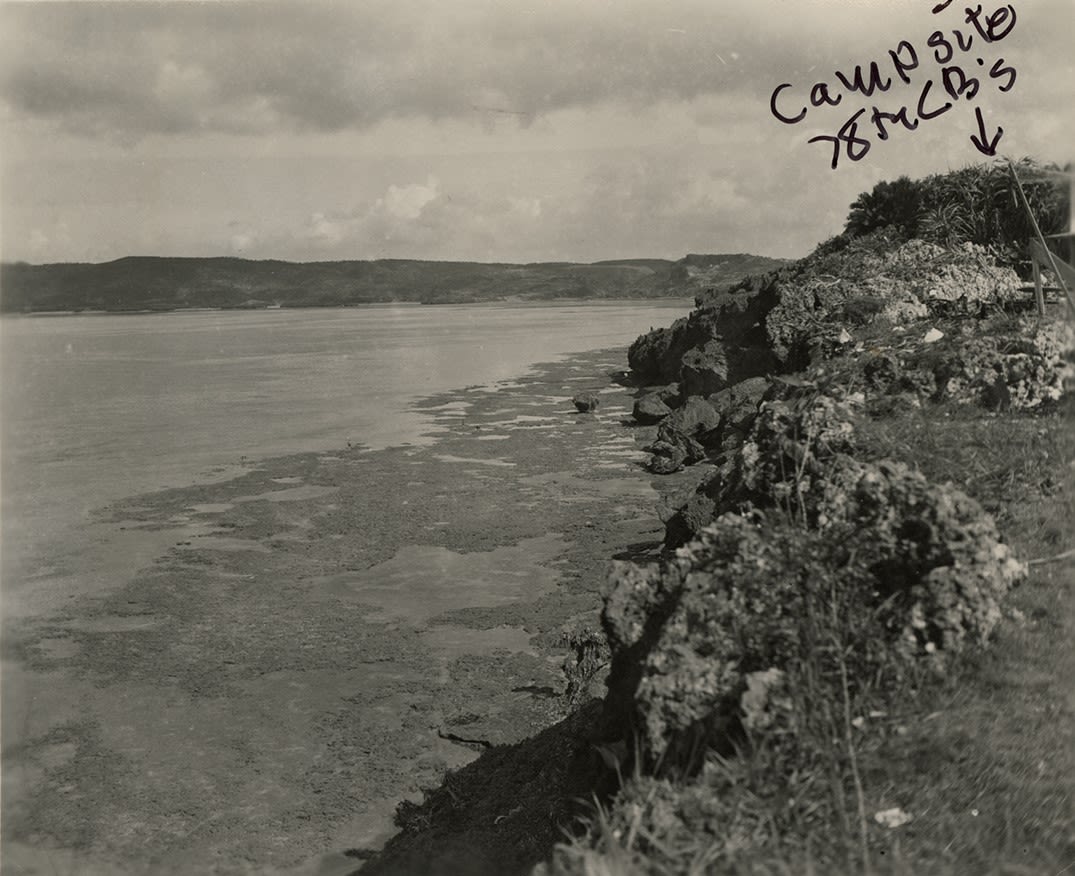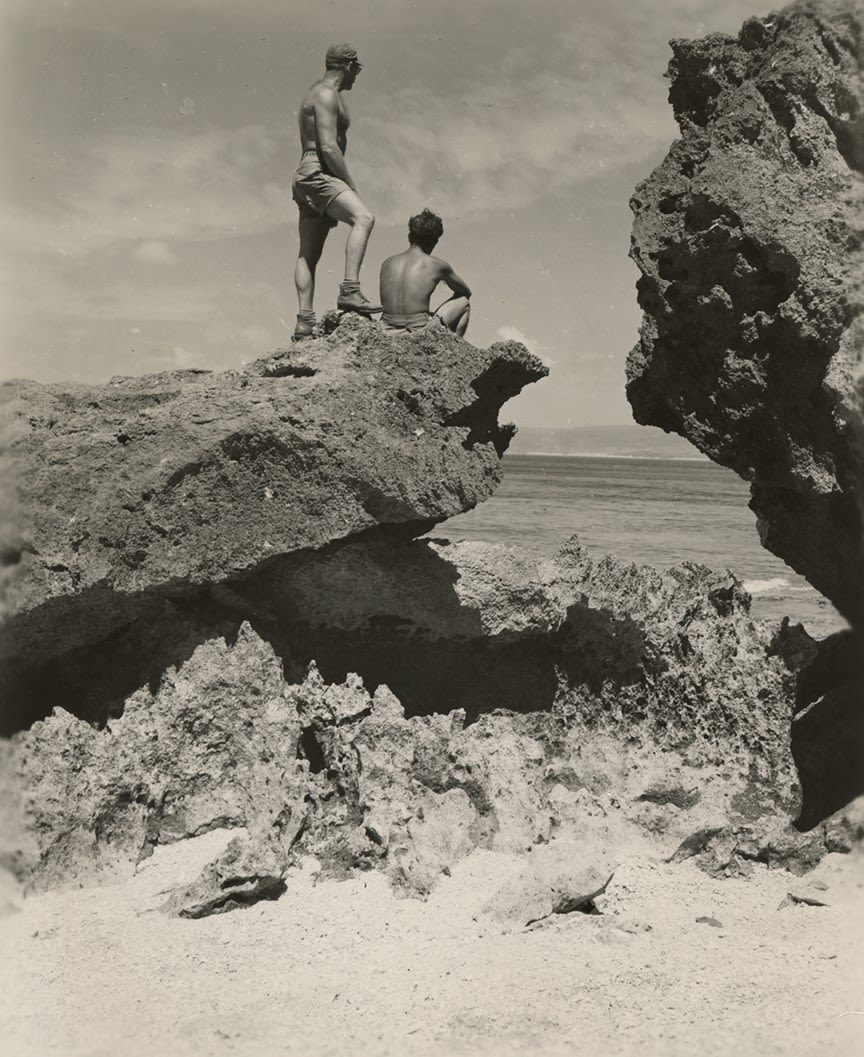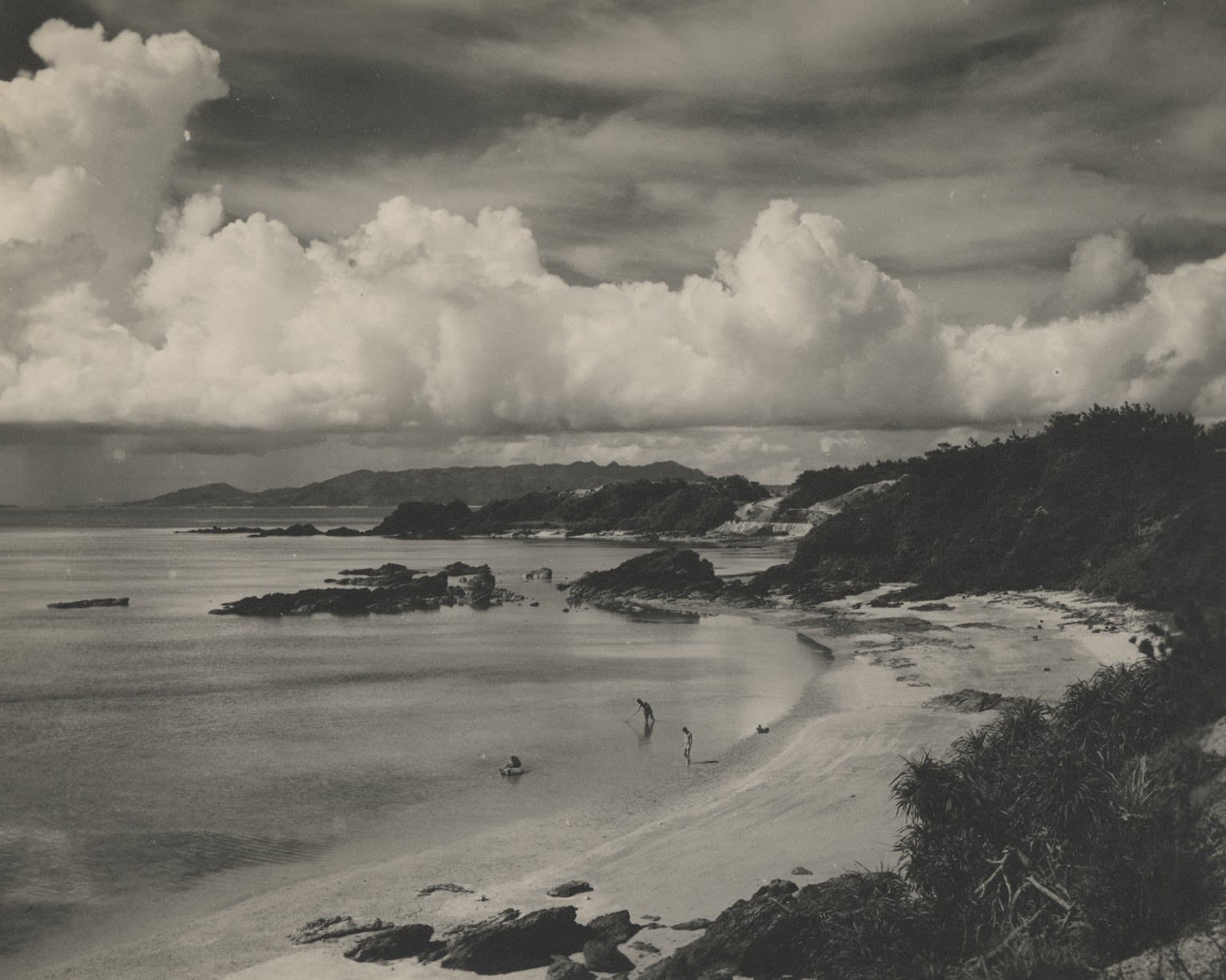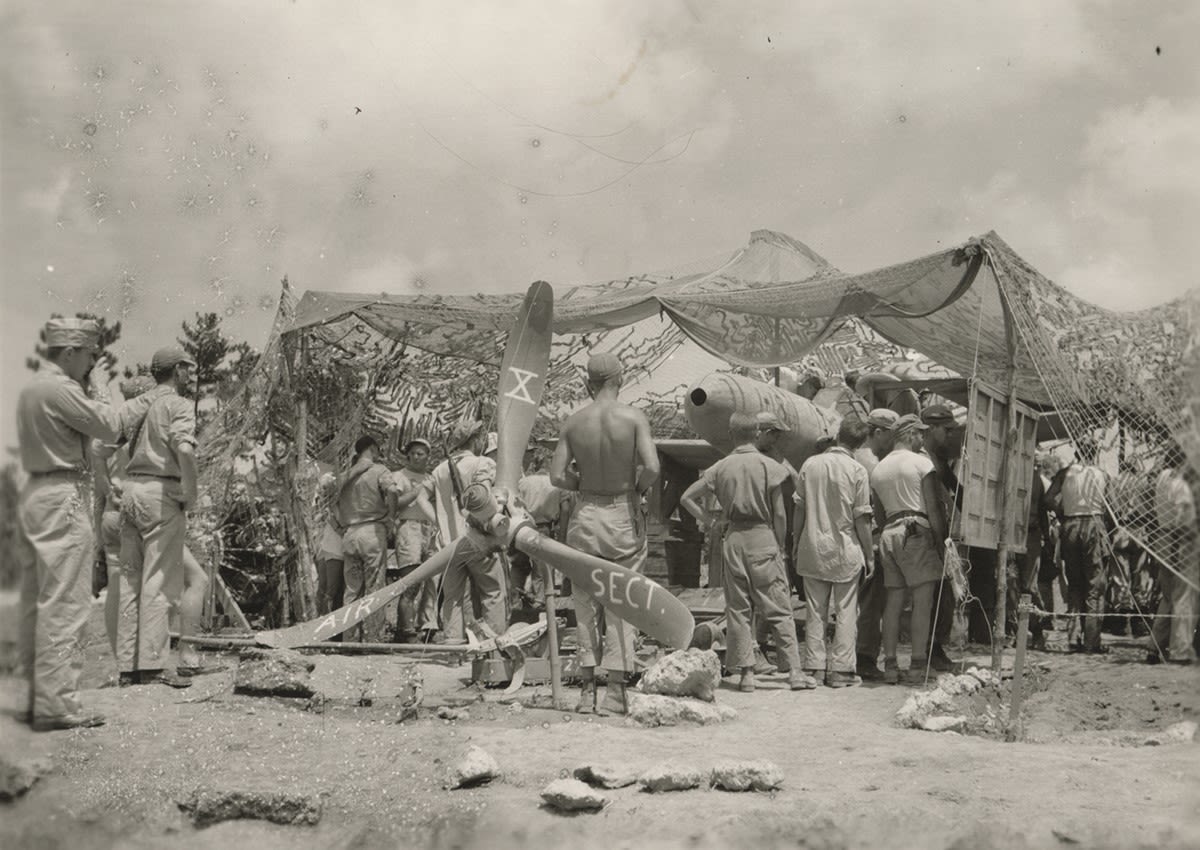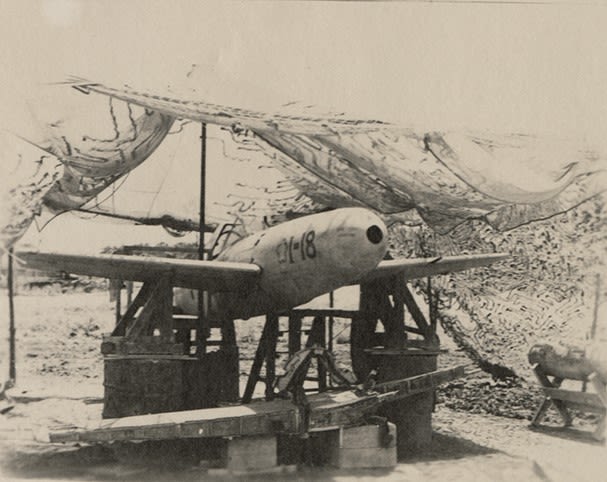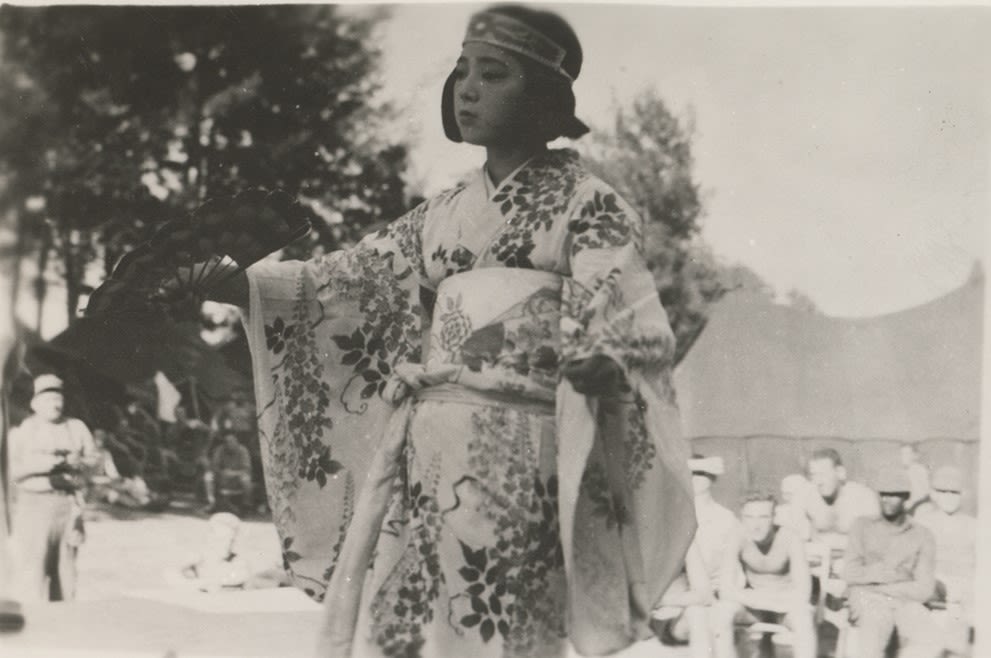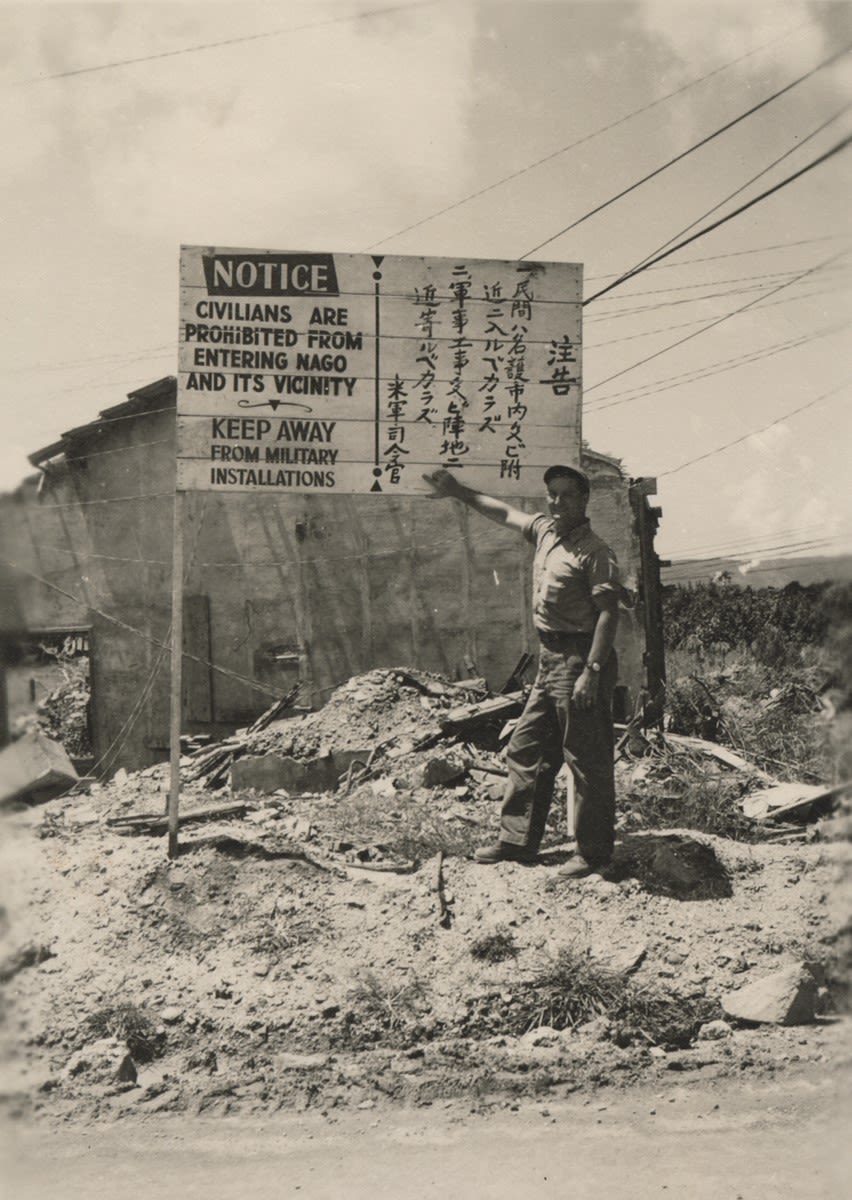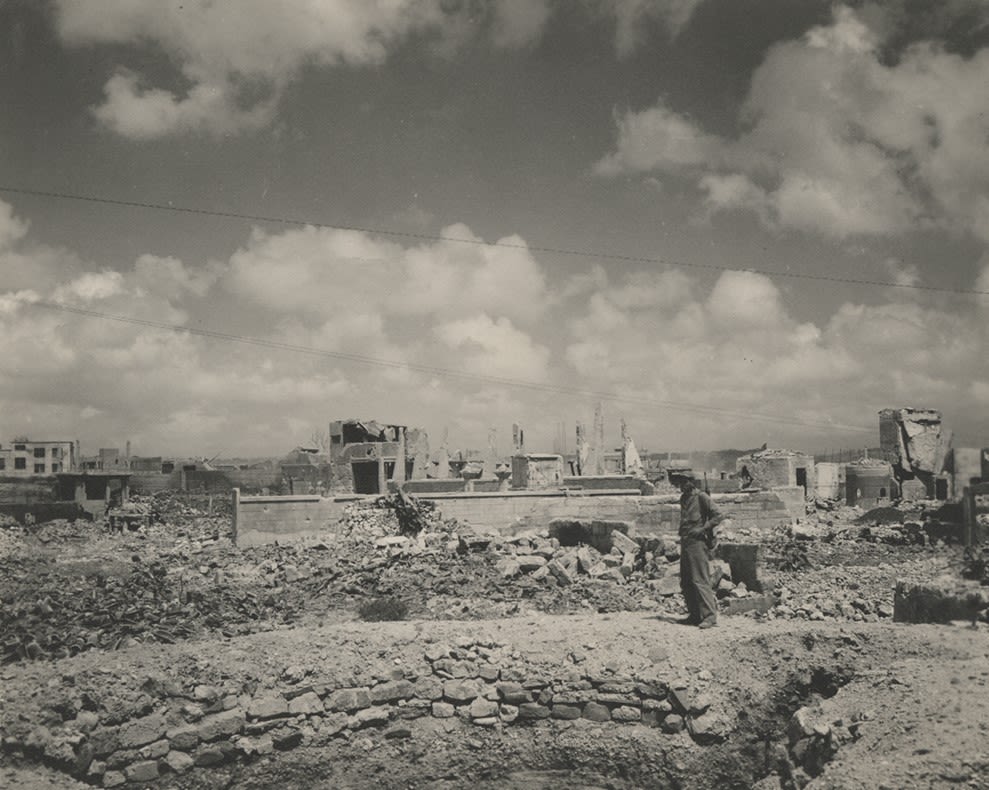Seabees At Ease
Downtime in the Pacific Theater of WWII

As a sailor in the US Navy’s 78th Construction Battalion (aka the Seabees) during World War II, Natale (Nat) Bellantoni lived and worked on various islands, facing jungle heat, tropical diseases, insects, snakes, and monsoon rains. Throughout this journey across the Pacific Ocean, Nat and his fellow Seabees served their country by building the bases needed to reach and defeat Japan, but there was more to life in the Pacific theater. While battles could feel eternal and construction projects never ending, even during a war there was always downtime.
For Nat, sketching and painting his surroundings was a cathartic way to get through these quiet spells. He also spent time with his buddies, taking photographs and caring for locally acquired pets. On New Caledonia, far from the front lines, the Seabees participated in R & R activities and enjoyed liberty—free time to tour the capital of Nouméa and explore the hinterlands. These moments of peace did not divorce these servicemen from the reality of being in a theater of war, but instead helped them survive this challenging period of their lives with a sense of normalcy and home.
Artists In War
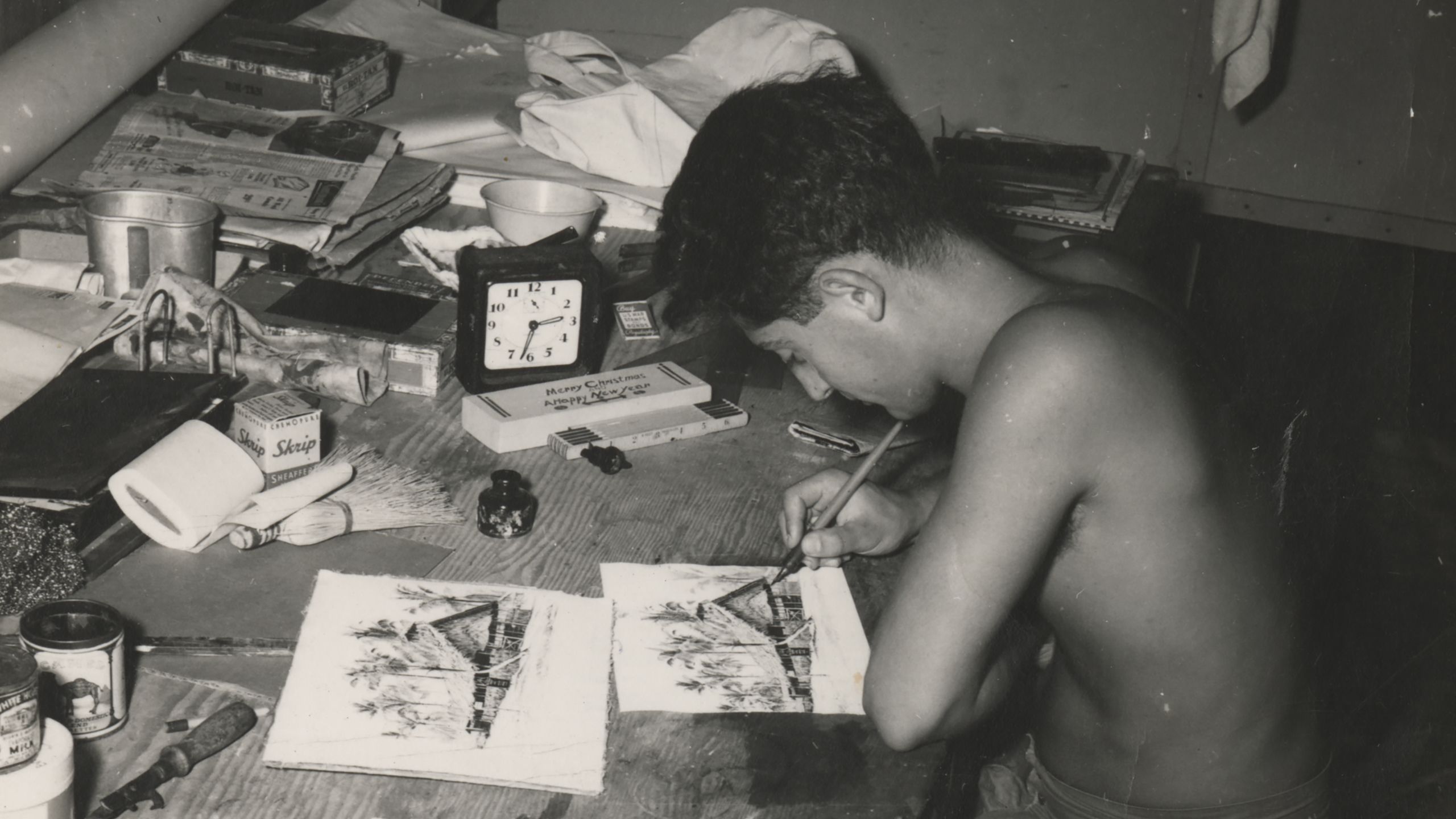
Whenever there are wars, there are soldiers documenting their experiences through visual media. Whether painting, sketching, or whittling, artists in active duty create some of the most evocative records of warfare. In World War II, the Navy even established the Combat Art Program to officially document all phases of the war. But many artists of the war did not serve in that program or in any official capacity. They would keep and draw in pocket sketchbooks, paint on the noses of aircraft, or compose watercolors while on liberty.
Nose art on two B-25 bomber aircraft, n.d.
Nose art on two B-25 bomber aircraft, n.d.
When Nat Bellantoni decided to use his skills in drafting, sketching, architecture, and photography in service with the Seabees, he knew that the best way to manage the narrative of his life and to cope with the ups and downs of his feelings was to create images—visual records that spoke of what he felt, as well as what he saw. His personal archive is filled with this material and reveals the life of an artist interrupted.
Chapel Art
With a variety of skills recently honed at the Massachusetts School of Art—and being from Boston’s Italian Catholic community—Nat contributed many artistic details to the chapels used by the 78th Seabees. Above is an interior photograph of a chapel, which shows a painting by Nat above the altar. At right is Nat with a stained-glass window he created for the Lorengau Memorial Chapel on Manus Island in the Admiralty group. This was a particularly unique piece, since proper materials were inaccessible. Nat ingeniously took cello-glass screen from a wrecked Quonset hut and painted on it with oil paint (thinned to transparency) over a lacquer base in order to skillfully create a four-color design.
Nat Bellantoni's sketchbooks, 1943-1945. Digital Record
Nat Bellantoni's sketchbooks, 1943-1945. Digital Record
Nat Bellantoni holding his stained-glass window for the Lorengau Memorial Chapel, Manus Island, 1944.
Nat Bellantoni holding his stained-glass window for the Lorengau Memorial Chapel, Manus Island, 1944.
Ed Keegan, by Natale Bellantoni, n.d.
Of the hundreds of photographs in Nat's archive, very few are identified as having been taken by him. This is one of those unique finds, a candid snapshot by him of good friend and battalion photographer Edwin Keegan.
Ed Keegan, by Natale Bellantoni, n.d.
Of the hundreds of photographs in Nat's archive, very few are identified as having been taken by him. This is one of those unique finds, a candid snapshot by him of good friend and battalion photographer Edwin Keegan.
Ed Keegan, n.d.
The lighthearted and artistic nature of Nat and his buddies is evident in this playful composition, which was clearly not part of the official war documentation effort. But what it does reveal is the type of camera used by battalion photographer Edwin Keegan: a Graflex Speed Graphic 4x5 large-format camera. This type of camera was used extensively by the US military in World War II.
Ed Keegan, n.d.
The lighthearted and artistic nature of Nat and his buddies is evident in this playful composition, which was clearly not part of the official war documentation effort. But what it does reveal is the type of camera used by battalion photographer Edwin Keegan: a Graflex Speed Graphic 4x5 large-format camera. This type of camera was used extensively by the US military in World War II.
Photograph development baths, New Caledonia, 1945.
At each new camp, Nat and his photographer and draftsman buddies had to set up a new studio for their work. Included would be bunks, desks, drafting tables, and a darkroom to develop photographs.
Photograph development baths, New Caledonia, 1945.
At each new camp, Nat and his photographer and draftsman buddies had to set up a new studio for their work. Included would be bunks, desks, drafting tables, and a darkroom to develop photographs.
Creative Photography in the Field
Part of the fun Nat had during downtime was manipulating photographs. For the image below, a landscape photograph was used as the backdrop for a cutout of a frog. Photographs of three Seabees were cut out and placed into a makeshift landscape of real twigs, fern leaves, and other foliage. A photograph of the staged miniature scene was then taken. While this creation is on the fantastical side, at right is a more straightforward photo manipulation project romantically created by Nat in which his fiancée, Irene, appears to be on the beach with him.
Nat and Irene 'together' on the beach, 1944–1945.
Nat and Irene 'together' on the beach, 1944–1945.
Bambi & Moon Bear
Mascots of the 78th Battalion

There have been famous mascots for military units throughout warfare. In the American Civil War, Old Abe was the beloved bald eagle mascot of the 8th Wisconsin Volunteer Infantry Regiment. In World War I, Rags (a mixed-breed terrier) was the canine mascot of the US 1st Infantry Division.
The men of the 78th Seabees also picked up local pets as mascots. On the Island of Ponam, in the Admiralty group, a local curiosity was found by James Wilson and Charles Tunnel—an Admiralty Island cuscus (a species of marsupial). It was given to Bruce Hulett of Company C and adopted as their beloved mascot Moon Bear.
Ed Keegan feeding Moon Bear, 1944.
Ed Keegan feeding Moon Bear, 1944.
During the battalion’s second tour of New Caledonia, in early 1945, Paul H. Bean found an orphaned Rusa deer fawn in the northern woods of the island. The men named it Bambi and instantly adopted it as their mascot.
Bambi with her caretakers (Paul Bean at left and Bill Wile at right), 1945.
Bambi with her caretakers (Paul Bean at left and Bill Wile at right), 1945.
Bean cared for Bambi until he left for stateside leave, at which time William Wile adopted the “chow-hound.” Nat drew an oversize portrait of Bambi, which he hung in the studio he shared with photographer Ed Keegan—who is seen happily feeding the fawn milk with a modified beer bottle in the photograph below.
Ed Keegan with Bambi, 1945.
Ed Keegan with Bambi, 1945.
Nat feeding Moon Bear, by Edwin Keegan, 1944. Inscribed by Nat to his fiancée Irene: Ora e sempre con amore! (Now and always with love!).
Nat feeding Moon Bear, by Edwin Keegan, 1944. Inscribed by Nat to his fiancée Irene: Ora e sempre con amore! (Now and always with love!).
Nat's portrait of Bambi hanging above a bunk and Ed's desk, New Caledonia, 1945.
Nat's portrait of Bambi hanging above a bunk and Ed's desk, New Caledonia, 1945.
Dog, n.d.
While it is unknown if this pup was adopted by men of the 78th, this charming snap was sent home for Irene to see.
Dog, n.d.
While it is unknown if this pup was adopted by men of the 78th, this charming snap was sent home for Irene to see.
Cat, n.d.
Cat, n.d.
Frog, by Edwin Keegan, n.d.
Frog, by Edwin Keegan, n.d.
Far from the Front
Recreation on New Caledonia
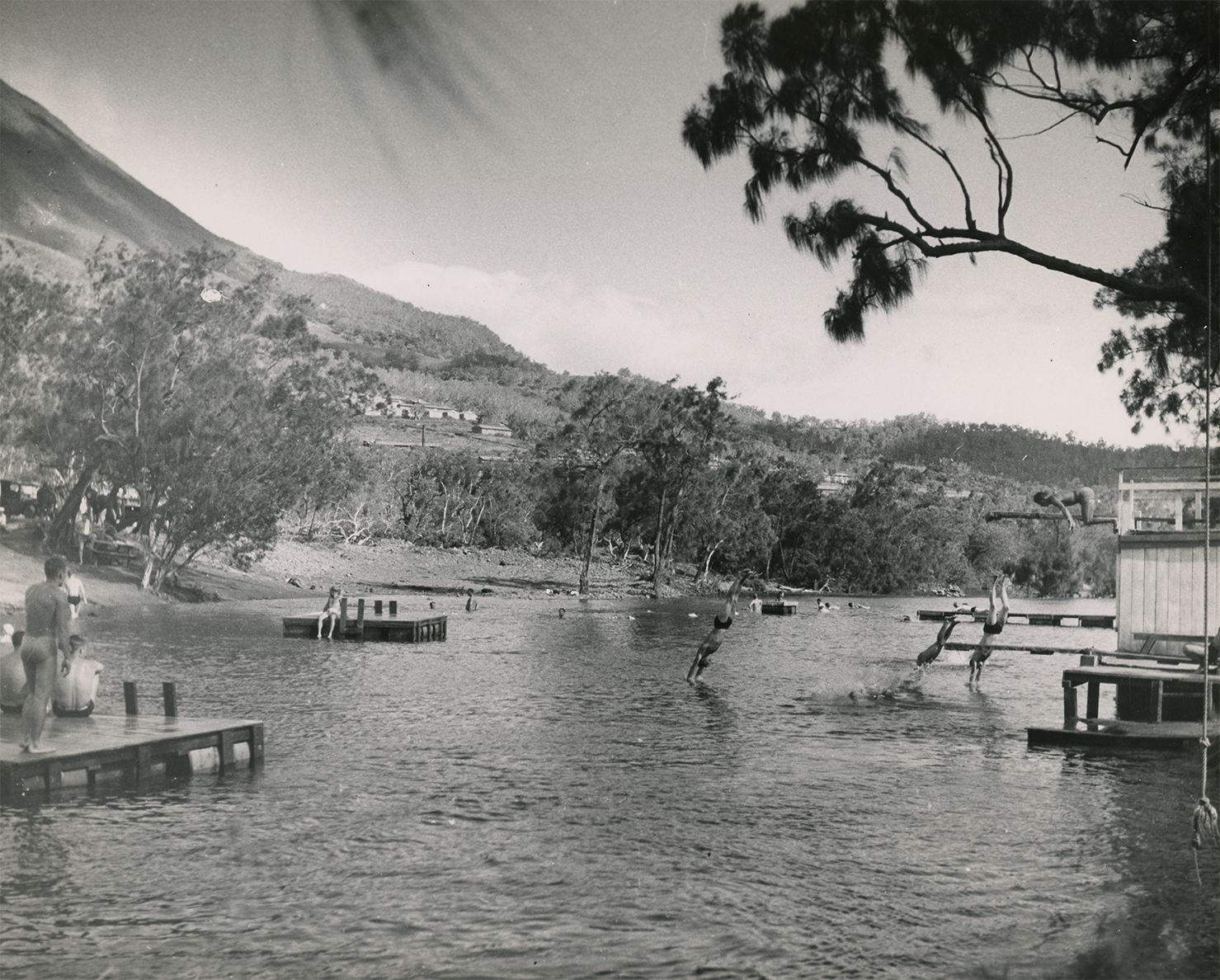
After a twelve-month period of continuous duty near the front lines, the 78th were relieved to be assigned to the relative safety of New Caledonia in December 1944. Billeted in Quonset huts in the shadow of Mont Dore, they performed mainly routine duties, which gave them almost unlimited time for liberty.
Camp with Quonset huts in the shadow of Mont Dore, 1945.
Camp with Quonset huts in the shadow of Mont Dore, 1945.
Swimming Hole, New Caledonia, 1945.
Swimming Hole, New Caledonia, 1945.
Swimming Class, New Caledonia, 1945.
Swimming Class, New Caledonia, 1945.
Water Skiing, New Caledonia, 1945.
Water Skiing, New Caledonia, 1945.
Touring the capital of Nouméa and visiting the surrounding farms and monasteries of the indigenous people and descendants of French colonists were just part of their fun. Photographs in Nat’s archive reveal swimming at the beach in Dumbéa, participating in the 78th’s baseball club, engaging in rifle practice, creating a victory garden, and building their third battalion chapel.
Al Perron, December 1944.
Al Perron, December 1944.
Seabees exploring New Caledonia, 1944.
Seabees exploring New Caledonia, 1944.
Saint Joseph's Cathedral, Nouméa, New Caledonia, 1943–1945.
Saint Joseph's Cathedral, Nouméa, New Caledonia, 1943–1945.
These people were swell to us - all sisters the little old lady in the center spoke Italian very well!! Downing & Jim, Noumea, New Caledonia [Note on back], 1945.
These people were swell to us - all sisters the little old lady in the center spoke Italian very well!! Downing & Jim, Noumea, New Caledonia [Note on back], 1945.
Comdr. Cameron (left) congratulates Chaplain Koffiin at dedication of field in honor of his fine work. 1945.
Comdr. Cameron (left) congratulates Chaplain Koffiin at dedication of field in honor of his fine work. 1945.
78th Baseball Club — SoPac and National League champions, New Caledonia, 1945.
“Winners of the SoPac league, victors over the National league champions and semi-finalists in the fight for the New Caledonia baseball title is the fine record achieved by the 78th Battalion team while stationed at New Caledonia in early 1945.” –The 78th’s Battalion Log, page 77.
78th Baseball Club — SoPac and National League champions, New Caledonia, 1945.
“Winners of the SoPac league, victors over the National league champions and semi-finalists in the fight for the New Caledonia baseball title is the fine record achieved by the 78th Battalion team while stationed at New Caledonia in early 1945.” –The 78th’s Battalion Log, page 77.
"Rube" Daniels strikes out, Ponam, 1944.
"Rube" Daniels strikes out, Ponam, 1944.
Ed Keegan photographing a Seabee looking across Magenta Bay to Mont Dore, New Caledonia, 1943–1945.
After returning to New Caledonia in December 1944, many of the 78th spent five days on unrestricted liberty. Nat and his buddies took a five day sight-seeing tour outside of the Noumea district to explore the rest of the island. This included visiting the villages of Houaliou, Kone, LaFoa and Bourail. There are many photos in Nat’s collection of the activities they got up to and the people they met along the way.
Ed Keegan photographing a Seabee looking across Magenta Bay to Mont Dore, New Caledonia, 1943–1945.
After returning to New Caledonia in December 1944, many of the 78th spent five days on unrestricted liberty. Nat and his buddies took a five day sight-seeing tour outside of the Noumea district to explore the rest of the island. This included visiting the villages of Houaliou, Kone, LaFoa and Bourail. There are many photos in Nat’s collection of the activities they got up to and the people they met along the way.
Al couldn't turn this shower off!! [Note on back] 1944–1945.
Al couldn't turn this shower off!! [Note on back] 1944–1945.
Ed said "The mule had a mind of its own." [Note on back] 1944–1945.
Ed said "The mule had a mind of its own." [Note on back] 1944–1945.
Up the island, New Caledonia [Note on back], 1944.
This photograph is one of many featuring the indigenous Kanak people of the island. Nat and his fellow Seabees were clearly fascinated by them but Nat’s archive is limited to the Seabee perspective of how the Kanak felt about this surge in Americans on the island: happy to meet them and hospitable.
Up the island, New Caledonia [Note on back], 1944.
This photograph is one of many featuring the indigenous Kanak people of the island. Nat and his fellow Seabees were clearly fascinated by them but Nat’s archive is limited to the Seabee perspective of how the Kanak felt about this surge in Americans on the island: happy to meet them and hospitable.
Summer home up the island. These people live in Noumea, New Caledonia [note on back], 1944.
There are also over a dozen photos of Caldoches, the native born descendants of French colonists on the island. Nat wrote to Irene of meeting these folks and their unique monasteries and chapels he found in the hinterlands.
Summer home up the island. These people live in Noumea, New Caledonia [note on back], 1944.
There are also over a dozen photos of Caldoches, the native born descendants of French colonists on the island. Nat wrote to Irene of meeting these folks and their unique monasteries and chapels he found in the hinterlands.
Mont Dore Chapel, New Caledonia, 1945.
This is the third battalion chapel the 78th built during the war. Behind the chapel, the battalion managed a large Victory Garden with a specially rigged wood barrier that routed stream water into troughs for irrigation.
Mont Dore Chapel, New Caledonia, 1945.
This is the third battalion chapel the 78th built during the war. Behind the chapel, the battalion managed a large Victory Garden with a specially rigged wood barrier that routed stream water into troughs for irrigation.
Martha O'Driscoll, 1945.
An American film actress from 1937 until 1947, Martha O’Driscoll toured with Errol Flynn and other entertainers in the USO in the early 1940s. She performed for the troops in the Aleutians in 1943 and the South Pacific in 1945.
Martha O'Driscoll, 1945.
An American film actress from 1937 until 1947, Martha O’Driscoll toured with Errol Flynn and other entertainers in the USO in the early 1940s. She performed for the troops in the Aleutians in 1943 and the South Pacific in 1945.
Stage, Okinawa, 1945.
The USO, United Services Organizations, put on 420,000 performances for American troops during World War II. The camps built throughout the Pacific had stages (such as this one) where both troops themselves and famous stars would perform to keep morale up. Performers varied from big names like Bob Hope to lesser known acts. But famed matter little to the service men and women who watched the shows and were temporarily transported away from the realities of war around them.
Stage, Okinawa, 1945.
The USO, United Services Organizations, put on 420,000 performances for American troops during World War II. The camps built throughout the Pacific had stages (such as this one) where both troops themselves and famous stars would perform to keep morale up. Performers varied from big names like Bob Hope to lesser known acts. But famed matter little to the service men and women who watched the shows and were temporarily transported away from the realities of war around them.
Comic Sid "Don't-bend-da-soot!" Gould (left) performs as part of the Fun for Your Money ensemble, New Caledonia, 1945.
Comic Sid "Don't-bend-da-soot!" Gould (left) performs as part of the Fun for Your Money ensemble, New Caledonia, 1945.
The Neptunes perform behind a member of O'Driscoll Troupe, 1945.
The Neptunes perform behind a member of O'Driscoll Troupe, 1945.
They knew the good times would not last forever. By June, the men of the 78th were aboard the USS J. Franklin Bell, on their way to building a base of operations to launch the invasion of Japan.
Seabees lined up for a toast, New Caledonia, 1944–1945.
Seabees lined up for a toast, New Caledonia, 1944–1945.
Seabees Sightseeing
Touring Okinawa After V-J Day

The Battle of Okinawa was the largest amphibious assault in the Pacific theater and lasted from April to June 1945. It was a strategic push by the Allies to gain territory and establish bases for the invasion of the Japanese mainland. But that invasion never happened. On August 15, 1945, the Japanese surrendered—just days after the dropping of atomic bombs on Hiroshima and Nagasaki.
Aerial view of Bolo Point (looking south) with Navy ships at anchor in Hagushi Bay, Okinawa, 1945.
Aerial view of Bolo Point (looking south) with Navy ships at anchor in Hagushi Bay, Okinawa, 1945.
The 78th Seabees had arrived on Okinawa June 17 and were stationed at Bolo Point Airfield. But upon the formal surrender of Japan on September 2, known as Victory over Japan (V-J) Day, Nat and his buddies had more free time on their hands. The process of American servicemen returning home was a long one. Nat remained on Okinawa for several months and spent time as many of the Americans did, exploring the beauty of the island, its people, and their culture. But his almost tourist-like photographs showing this side of Japan are in stark contrast with others he took showing the devastation recently wrought by the tragedy of war.
After V-J Day we turned in all our G.I. equipment - what a blessing! [Note written on back], 1945.
After V-J Day we turned in all our G.I. equipment - what a blessing! [Note written on back], 1945.
Note written by Nat to his fiancée Irene on the back of the below photograph, 1945.
Note written by Nat to his fiancée Irene on the back of the below photograph, 1945.
Nat at an unidentified shrine, Okinawa, by Edwin Keegan, 1945.
Nat at an unidentified shrine, Okinawa, by Edwin Keegan, 1945.
North eastern coast of Bolo Point (looking south) showing the edge of the 78th Seabees' campsite, Okinawa, 1945.
With the extra free time Nat and his buddies took many photos of the beautiful Okinawan coast—especially the rocky cliffs below their campsite.
North eastern coast of Bolo Point (looking south) showing the edge of the 78th Seabees' campsite, Okinawa, 1945.
With the extra free time Nat and his buddies took many photos of the beautiful Okinawan coast—especially the rocky cliffs below their campsite.
Frank Denny and Nat Bellantoni, Okinawa, 1945.
Nat jotted on the back of this photo a note that he and Frank are on the rocks directly below their tent. On another shot the of rocks below their tent he mentioned how easy it was to get lost down there.
Frank Denny and Nat Bellantoni, Okinawa, 1945.
Nat jotted on the back of this photo a note that he and Frank are on the rocks directly below their tent. On another shot the of rocks below their tent he mentioned how easy it was to get lost down there.
Swimming at an unidentified beach, Okinawa, 1945.
Swimming at an unidentified beach, Okinawa, 1945.
Viewing captured plane, 1945.
One activity Nat and other service men participated in was viewing captured Japanese tools of war, including this Yokosuka MXY7 Ohka kamikaze aircraft. Here the men are viewing the I-18, which was captured at Yontan Airfield and today can be seen at the Planes of Fame Museum in Chino, California.
Viewing captured plane, 1945.
One activity Nat and other service men participated in was viewing captured Japanese tools of war, including this Yokosuka MXY7 Ohka kamikaze aircraft. Here the men are viewing the I-18, which was captured at Yontan Airfield and today can be seen at the Planes of Fame Museum in Chino, California.
Captured Japanese Yokosuka MXY7 Ohka, No. I-18, 1945.
This is a type of kamikaze suicide aircraft mainly used against US Navy ships during the 1945 Battle of Okinawa. They were generally carried to within range of a target by a bomber then dropped to glide towards the target before igniting its rocket engines for a high-speed diving attack on a ship. At Okinawa, kamikaze attacks sunk 17 US Navy vessels and damaged 279 others.
Captured Japanese Yokosuka MXY7 Ohka, No. I-18, 1945.
This is a type of kamikaze suicide aircraft mainly used against US Navy ships during the 1945 Battle of Okinawa. They were generally carried to within range of a target by a bomber then dropped to glide towards the target before igniting its rocket engines for a high-speed diving attack on a ship. At Okinawa, kamikaze attacks sunk 17 US Navy vessels and damaged 279 others.
Unidentified shrine, Okinawa, 1945.
This photo was developed on the same piece of paper as the prior image of the I-18 Ohka, but their relationship is unclear. Perhaps this was near Yontan Airfield, or perhaps they just happened to fit during development.
Unidentified shrine, Okinawa, 1945.
This photo was developed on the same piece of paper as the prior image of the I-18 Ohka, but their relationship is unclear. Perhaps this was near Yontan Airfield, or perhaps they just happened to fit during development.
Traditional Dancer, Okinawa, 1945.
Learning about the unique culture of Okinawa was a welcomed change of pace from fighting for the Americans. This woman performs an Eisan dance with a fan while accompanied by female musicians on a sanshin and a kutu.
Traditional Dancer, Okinawa, 1945.
Learning about the unique culture of Okinawa was a welcomed change of pace from fighting for the Americans. This woman performs an Eisan dance with a fan while accompanied by female musicians on a sanshin and a kutu.
Nat aboard a ruined train engine, 1945.
Much of the exploration of Okinawa presented Nat and his fellow Seabees with the tragic remains of the destruction wrought by war.
Nat aboard a ruined train engine, 1945.
Much of the exploration of Okinawa presented Nat and his fellow Seabees with the tragic remains of the destruction wrought by war.
Sign outside Nago, Okinawa, 1945.
Sign outside Nago, Okinawa, 1945.
Bombed-out city street, Okinawa, 1945.
Bombed-out city street, Okinawa, 1945.
Seabee exploring ruins, unidentified city, Okinawa, 1945.
Seabee exploring ruins, unidentified city, Okinawa, 1945.

Unless otherwise noted, all collection material shared in this presentation is part of the Natale Bellantoni Papers housed at the Hoover Institution Library & Archives, Stanford University.
The Hoover Institution Library & Archives has placed copies of these works online for educational and research purposes. If you would like to use any of these works, you are responsible for making your own legal assessment and securing any necessary permission. If you have questions about this resource or have concerns about the inclusion of an item, please contact the Hoover exhibits team:
Contact Us
For more information about rights and permissions please visit, https://www.hoover.org/library-archives/collections/get-help/right-and-permissions.
© 2022 by the Board of Trustees of Leland Stanford Junior University.

